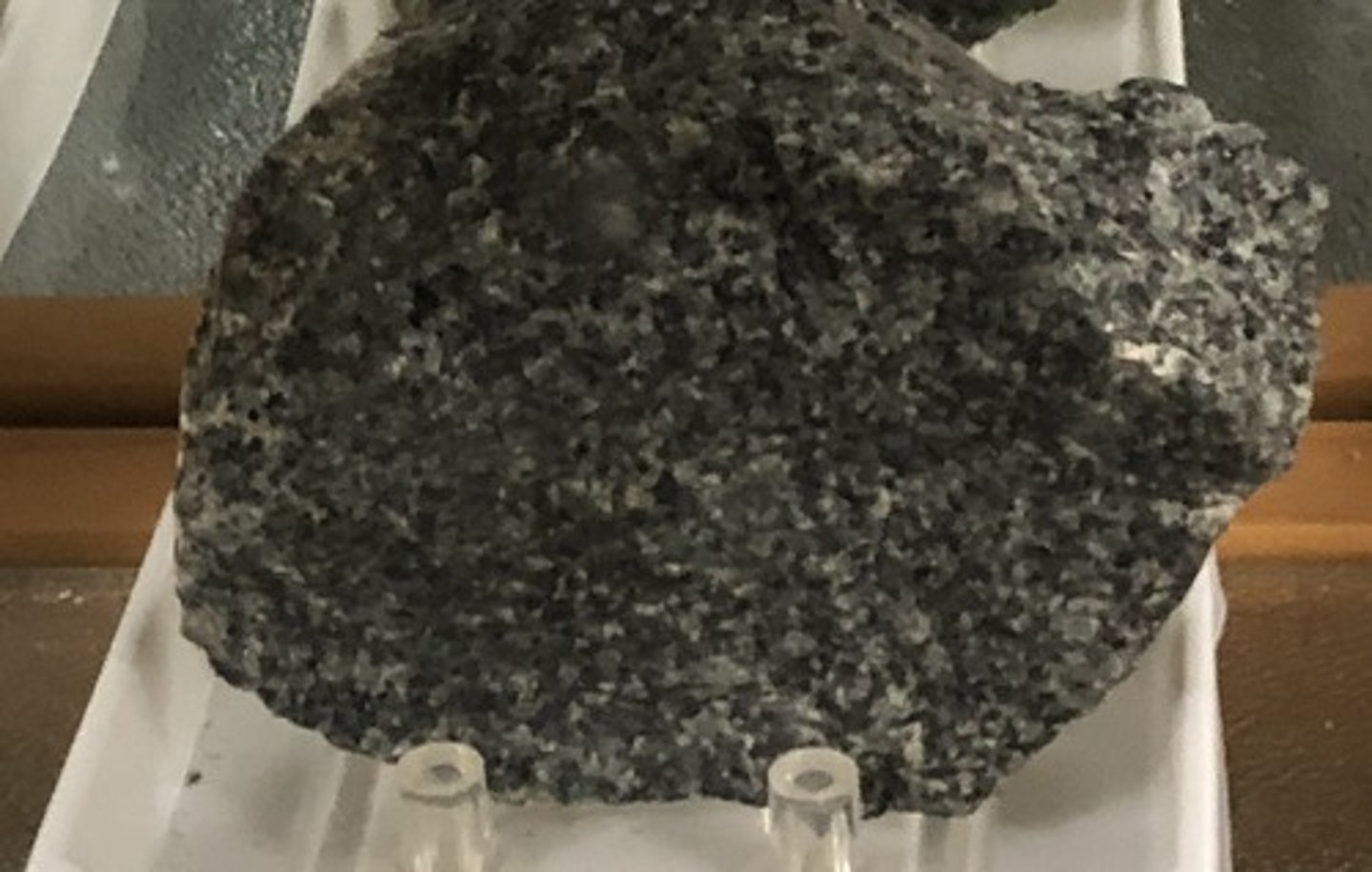Geology 1403 Lab Exam 1
1/102
There's no tags or description
Looks like no tags are added yet.
Name | Mastery | Learn | Test | Matching | Spaced |
|---|
No study sessions yet.
103 Terms
rocks that form from the accumulation of materials that originate and are transported as solid particles derived from both mechanical and chemical weathering.
Detrital Sedimentary Rocks
no visible quartz grains
Difference between diorite and granite?
repetitive layering or grain alignment
foliated metamorphic rock
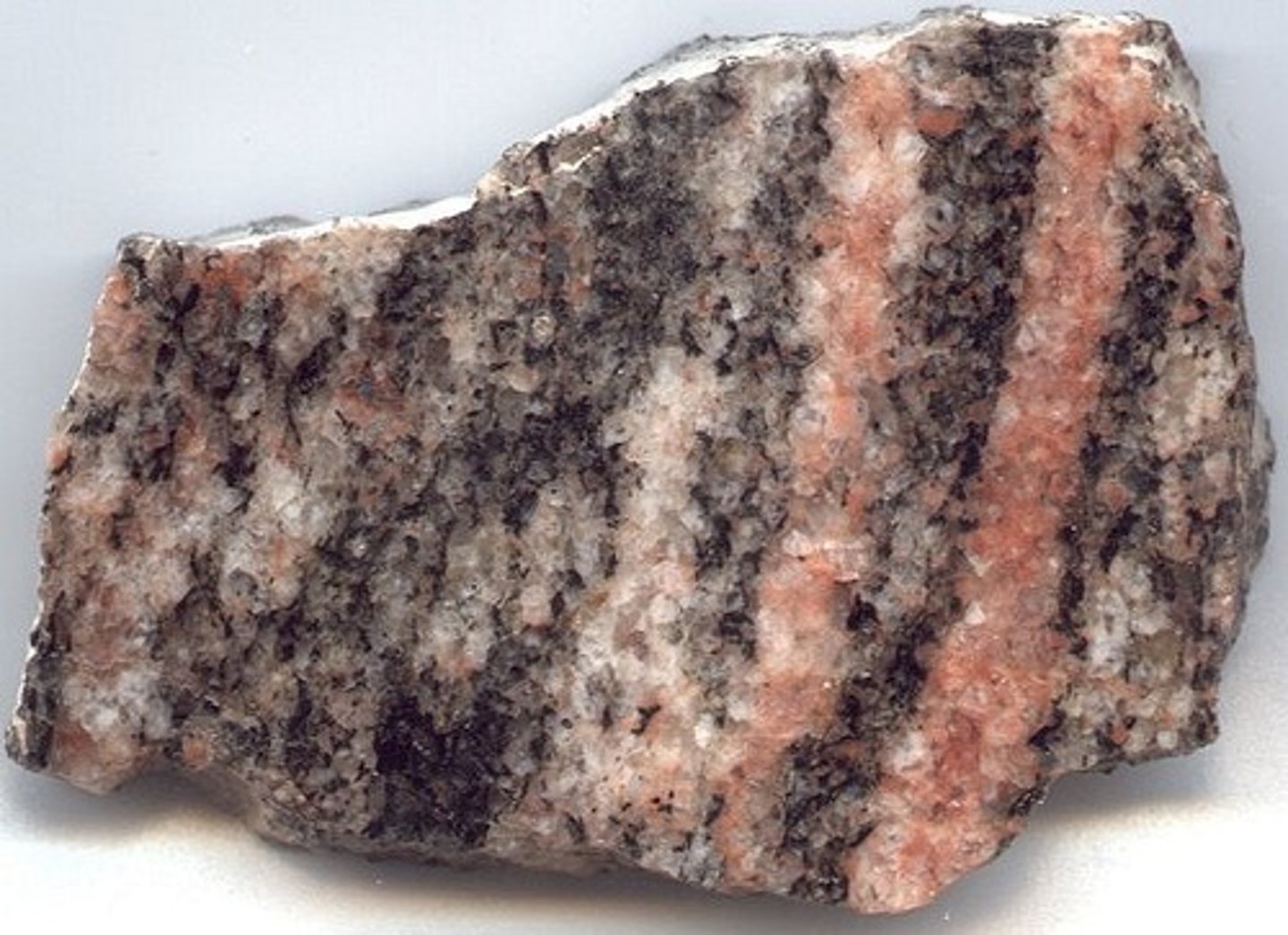
metamorphic rock that does not exhibit a banded or layered appearance
Non-Foliated Metamorphic Rock
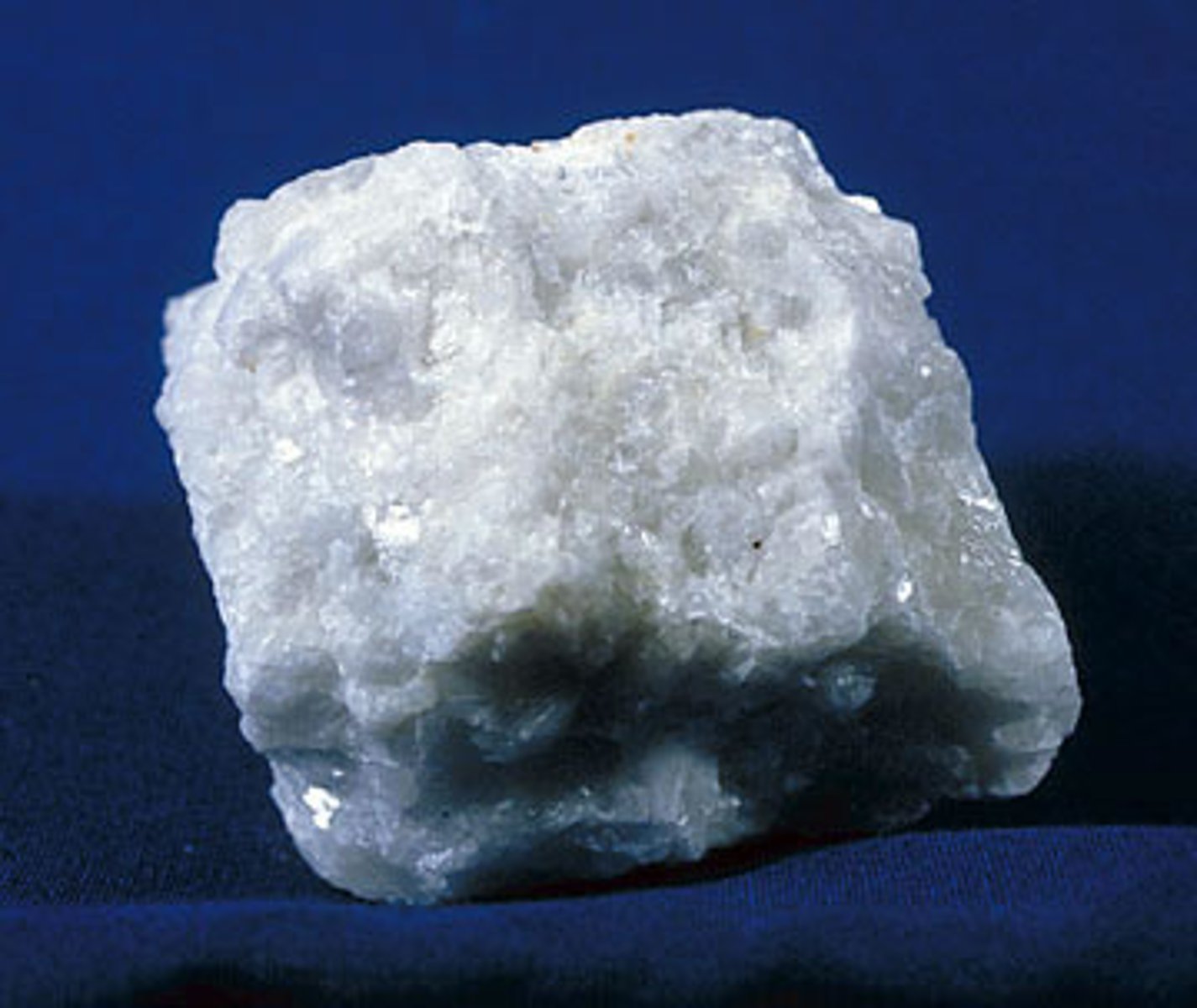
marble, quartzite, serpentinite, hornfels, anthracite coal
Metamorphic rocks that are non-foliated
slate, phyllite, schist, gneiss
Metamorphic rocks that are foliated
granite pegmatite, granite, rholite and pumice, obsidian and volcanic tuff can be
What are the felsic composition igneous rocks?
peridotite
What igneous rock is ultramafic?
Cleavage patterns in minerals
granite pegmatite, diorite pegmatite and gabbro pegmatite
What igneous rocks have pegmatitic texture?
granite, diorite, gabbro and peridotite
What igneous rocks have phaneritic texture?
granite, diorite, gabbro, rhyolite, andesite and basalt
What igneous rocks can have porphyritic texture?
rhyolite, andesite and basalt
What igneous rocks have aphanitic texture?
obsidian
What igneous rocks have glassy texture?
pumice and vesicular basalt
What igneous rocks have vesicular texture?
Gabbro pegmatit, gabbro, basalt, vesicular basalt and obsidian and volcanic tuff can be
What are the mafic composition igneous rocks?
diorite pegmatite, diorite, andesite, and pumice, obsidian and volcanic tuff can be
What are the intermediate igneous rocks?
Sedimentary Detrital, grain size: gravel (> 2mm) has rounded rock fragments and mineral grains
conglomerate
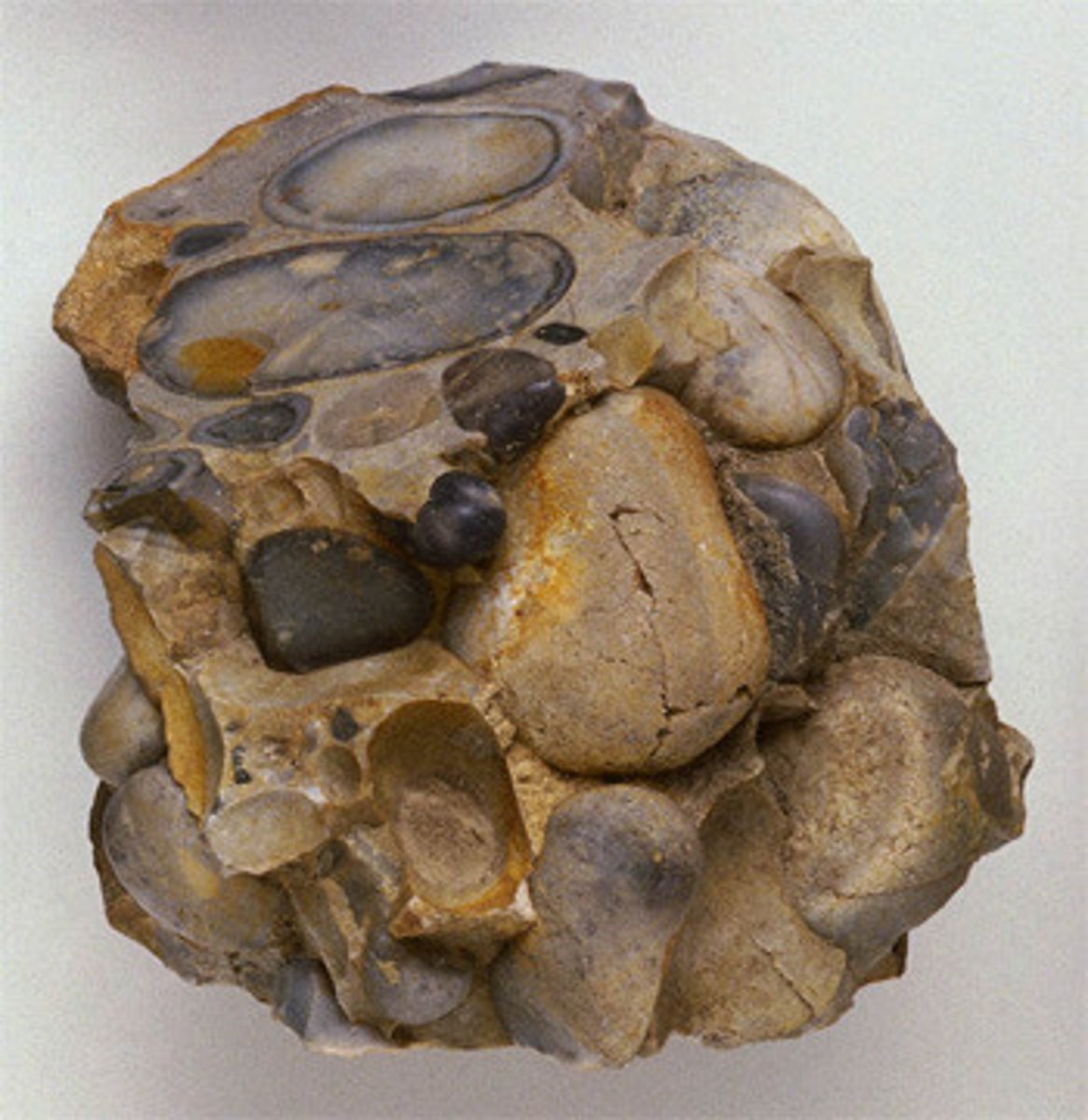
Sedimentary detrital, grain size: gravel (> 2mm), angular grains
Breccia

Sedimentary detrital, sand grain size, characterized by abundant feldspar (>15%), rock fragments and mineral grains
Arkose Sandstone
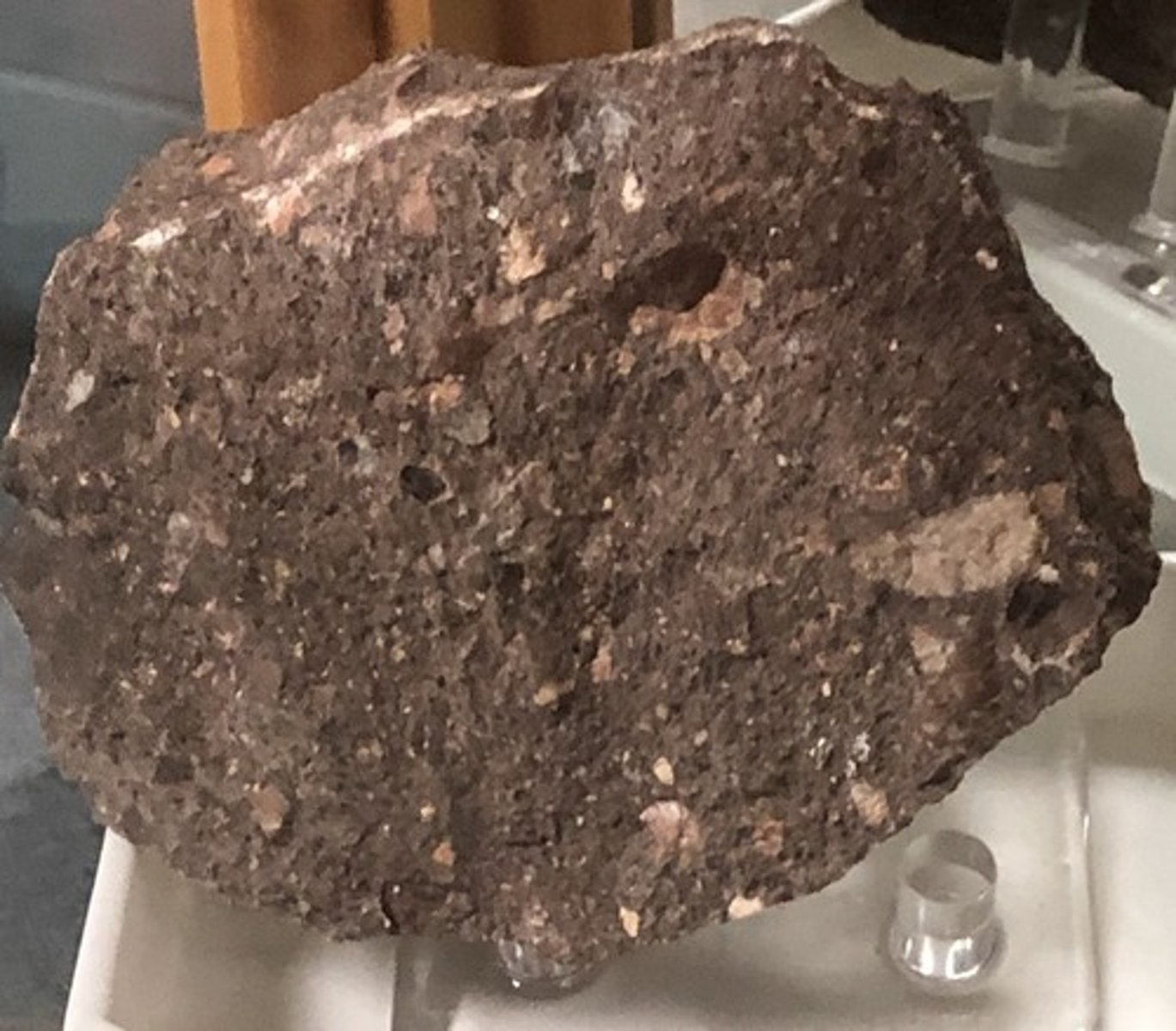
Sedimentary detrital(clastic), sand grain size, characterized by mostly q grains (>90%), grains often rounded
Quartz Sandstone
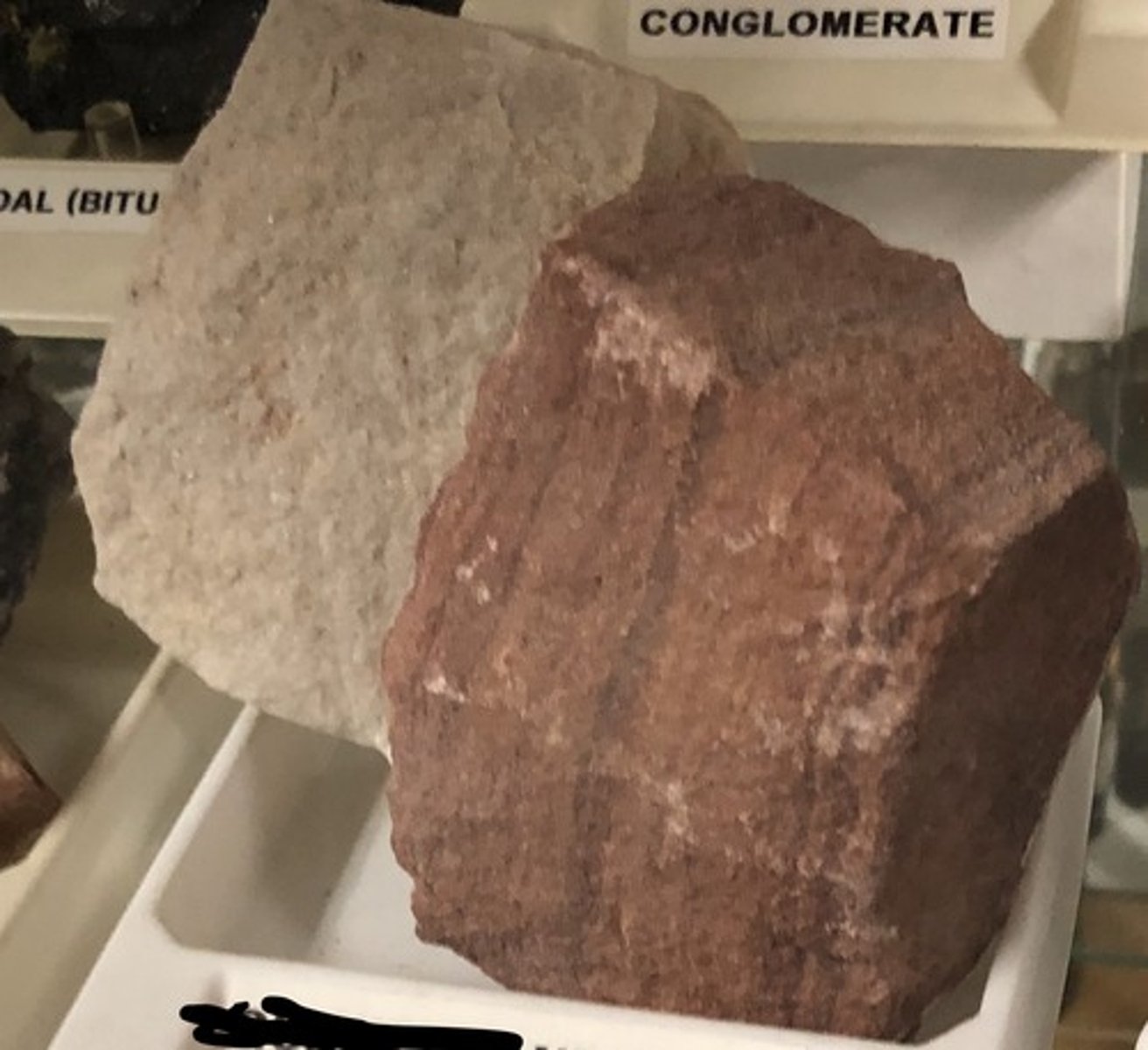
Sedimentary detrital (clastic), sand grain size, characterized by abundant rock fragments (>15%), sand sized quartz and minerals grains
Lithic Sandstone
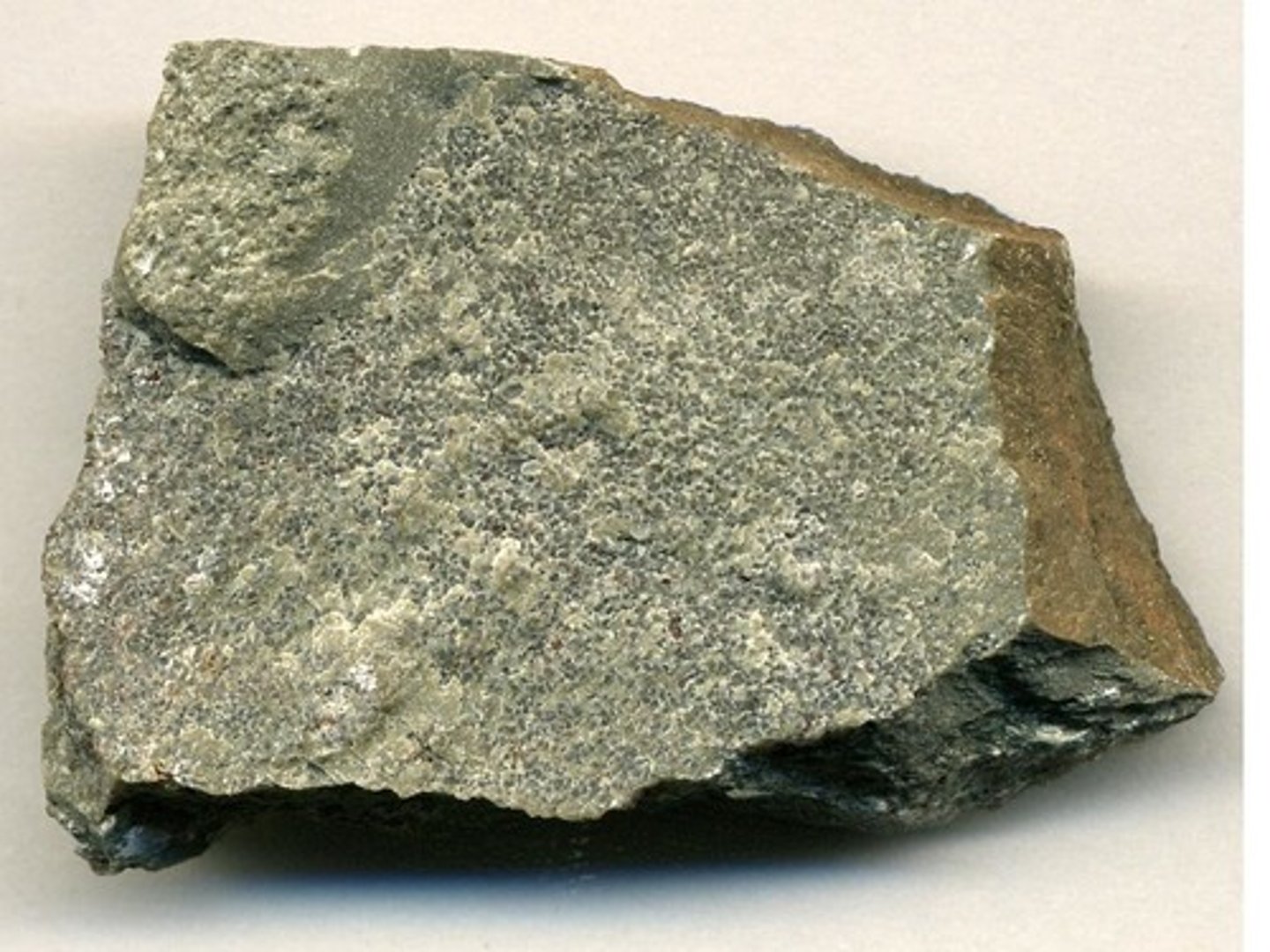
Sedimentary detrital, clay grain size, characterized by mostly clay minerals
Shale
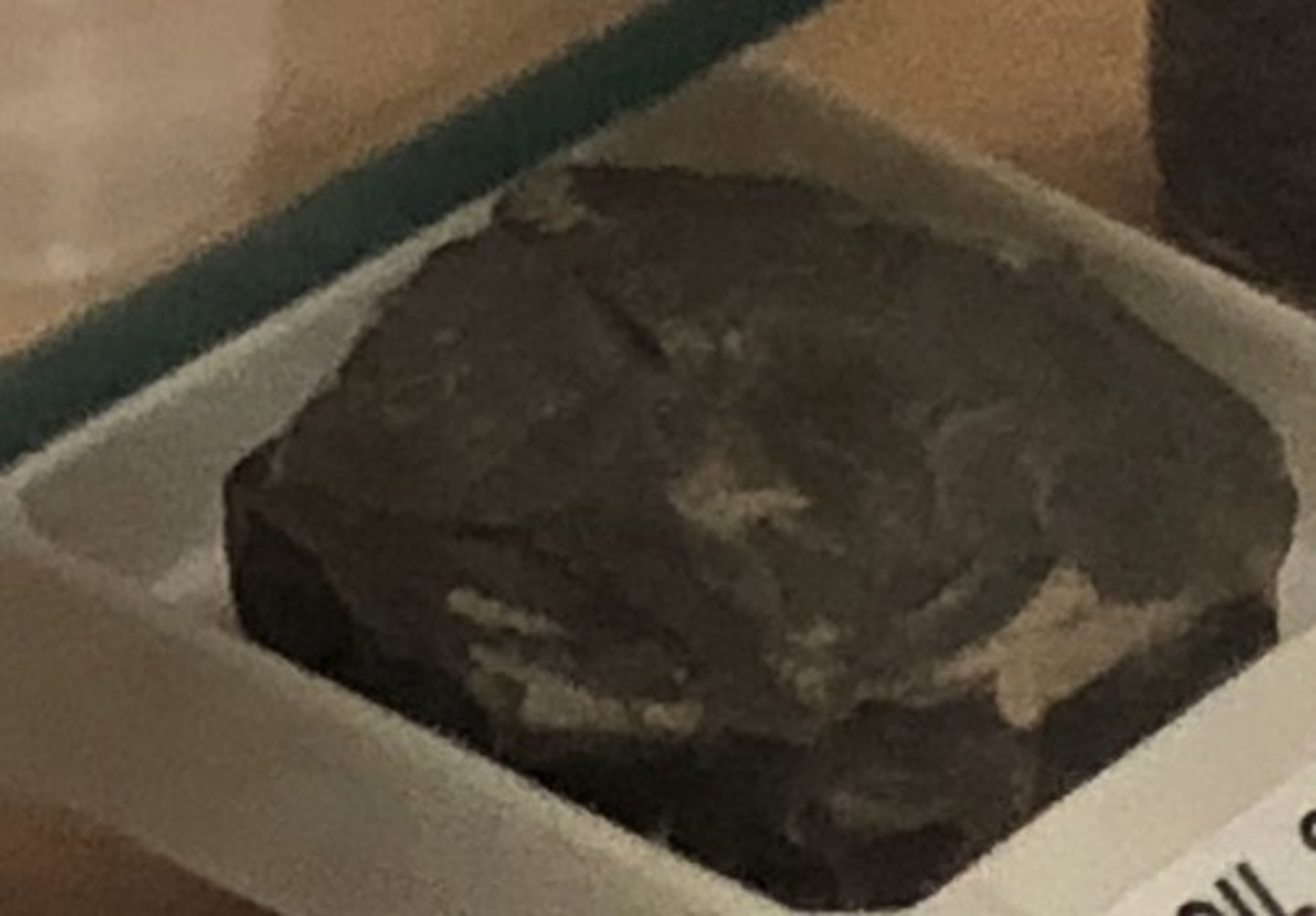
A sedimentary rock that forms from the chemical activities of organisms
Biochemical sedimentary rocks
Sedimentary rock that has undergone some form of chemical alteration (ex. precipitate from a solution or settle from a suspension)
chemical sedimentary rock
Sedimentary, biochemical chemical, composed of mainly calcite (CaCO3), fossilized shell in a fine grained matrix
Fossiliferous Limestone

Sedimentary, inorganic chemical, (composition: mainly calcite) (CaCO3), spherical grains with concentric laminations
Oolitic Limestone
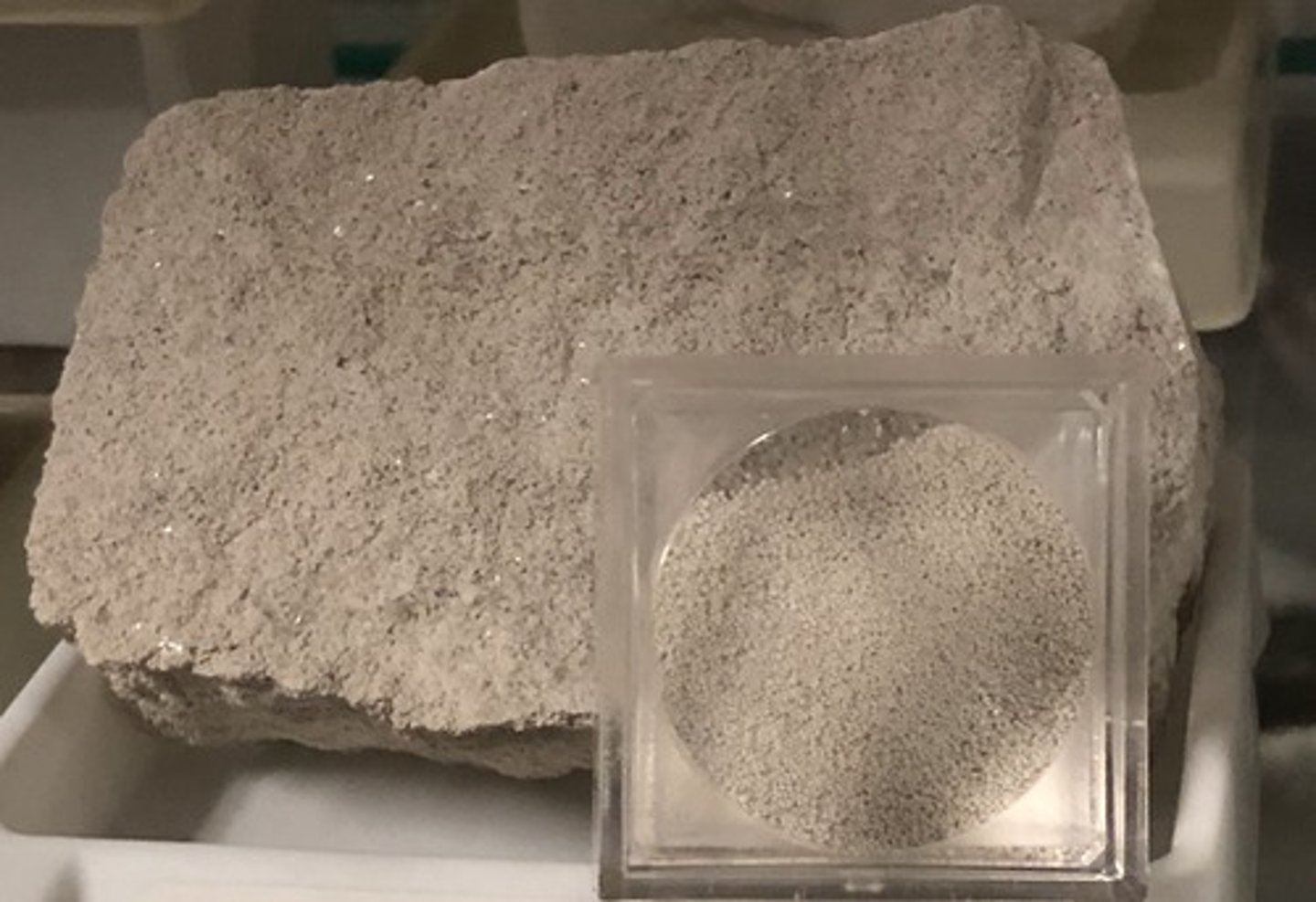
felsic to mafic, pyroclastic texture and extrusive
Volcanic Tuff
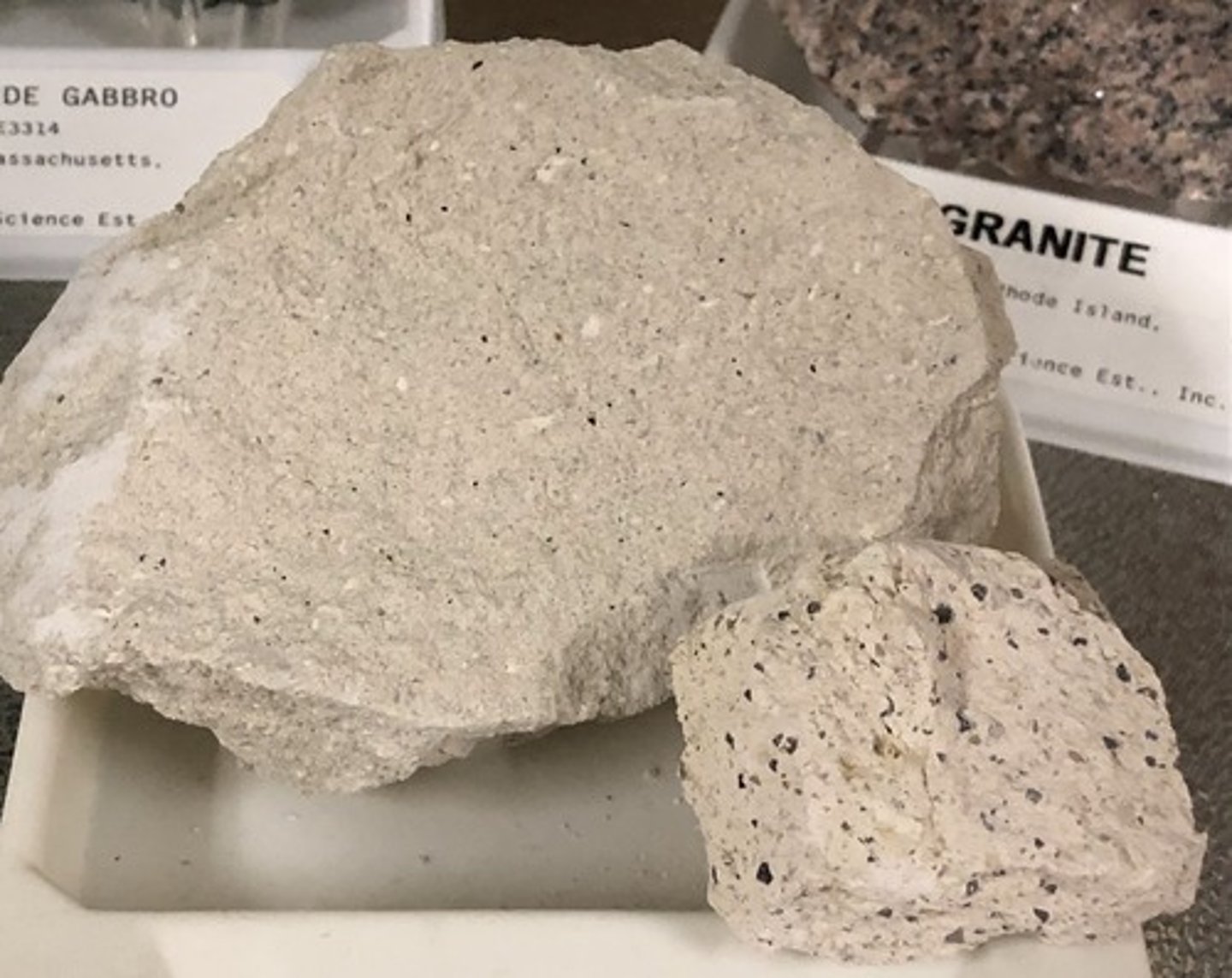
Biochemical chemical, Composition: mainly calcite (CaCO3), dull appearance and dense, uniform, fine grained rock with conchoidal fracture
Micrite (micritic limestone)

Sedimentary
microcrystalline
waxy appearance
conchoidal fracture
harder than glass
inorganic
Chert
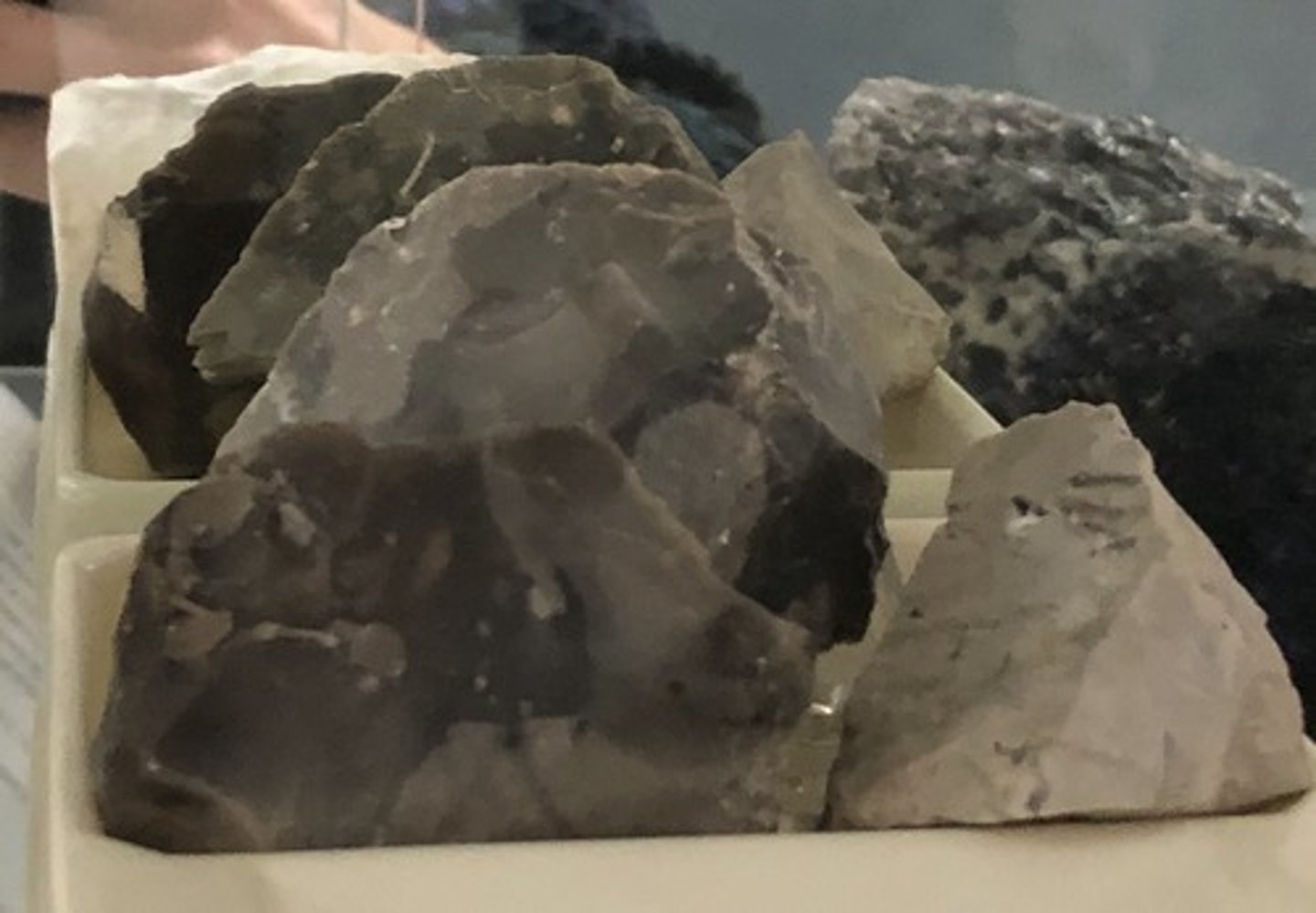
wavy subparallel veins of lighter coloration and are visible on all surfaces of sample
exsolution lamellae
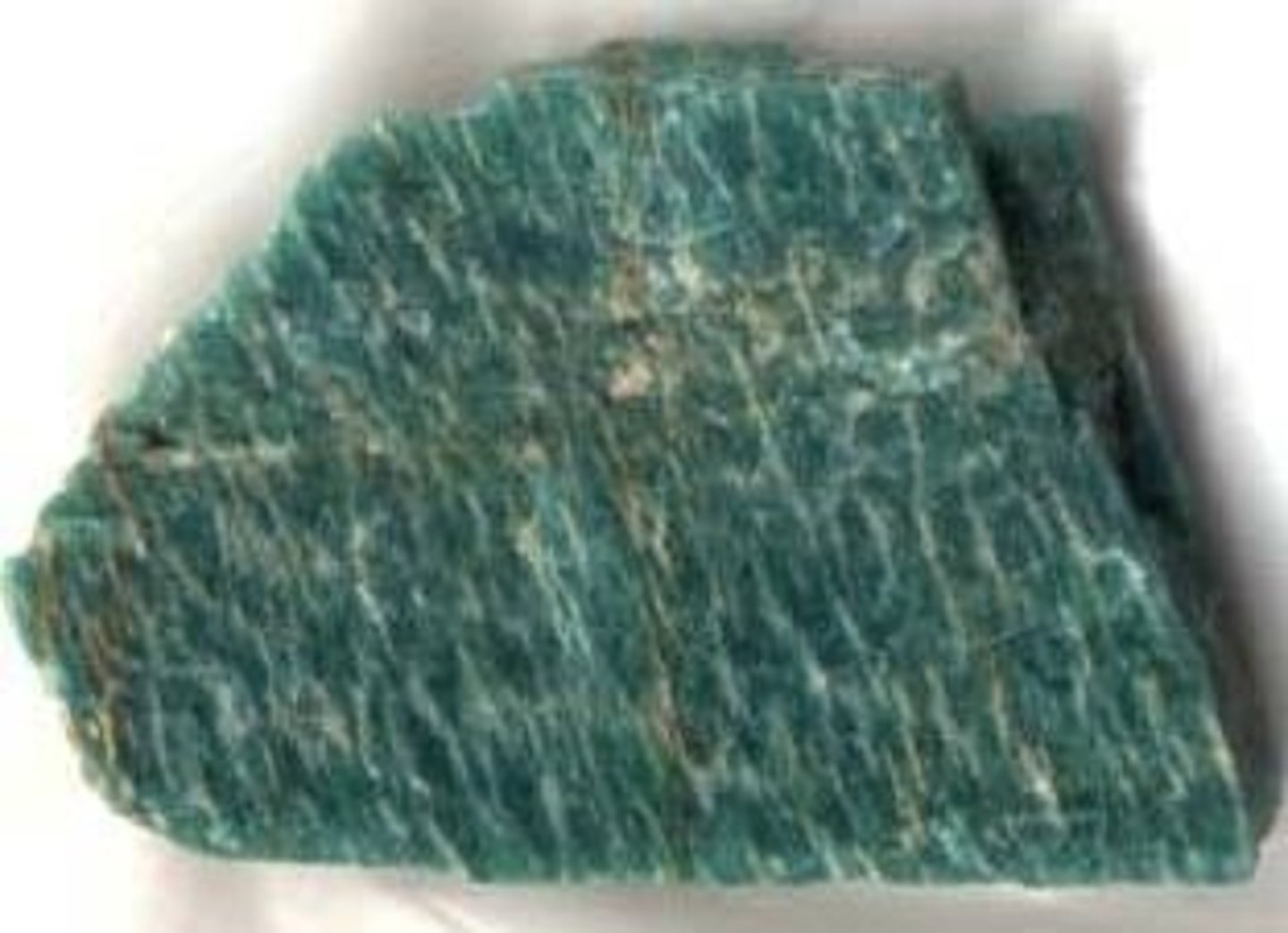
very thin, parallel grooves that are usually visible on only one cleavage surface of a sample
Striations
inorganic chemical, (composition: mainly halite (NaCl)), crystalline, salty taste and softer than glass
Rock Salt
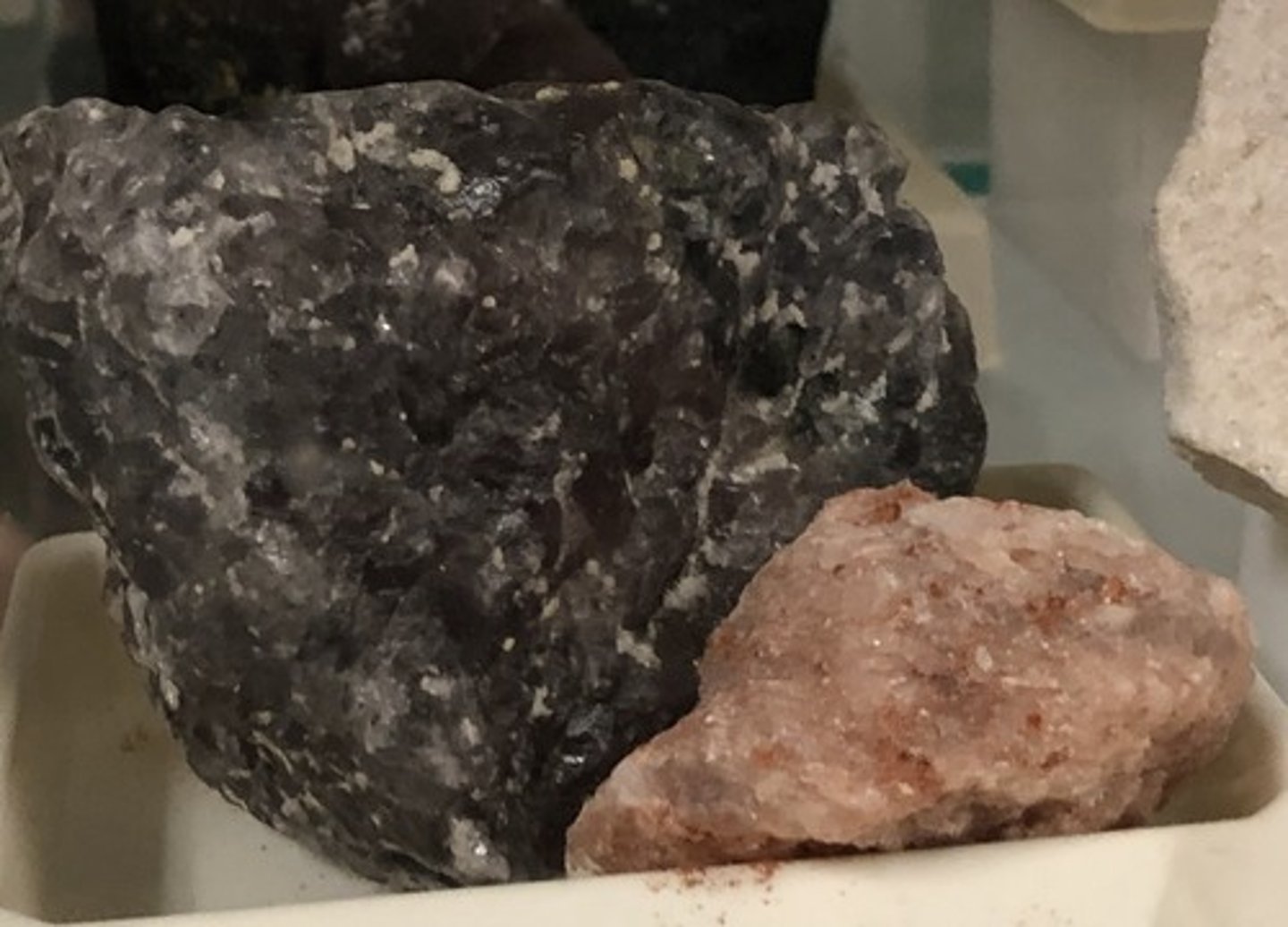
Biochemical, composed of carbonized plant fragments, brown to brownish black, brittle and sooty
Lignite

sedimentary, Biochemical, (composed of calcite mainly), characterized by microscopic shells and powdery look
Chalk
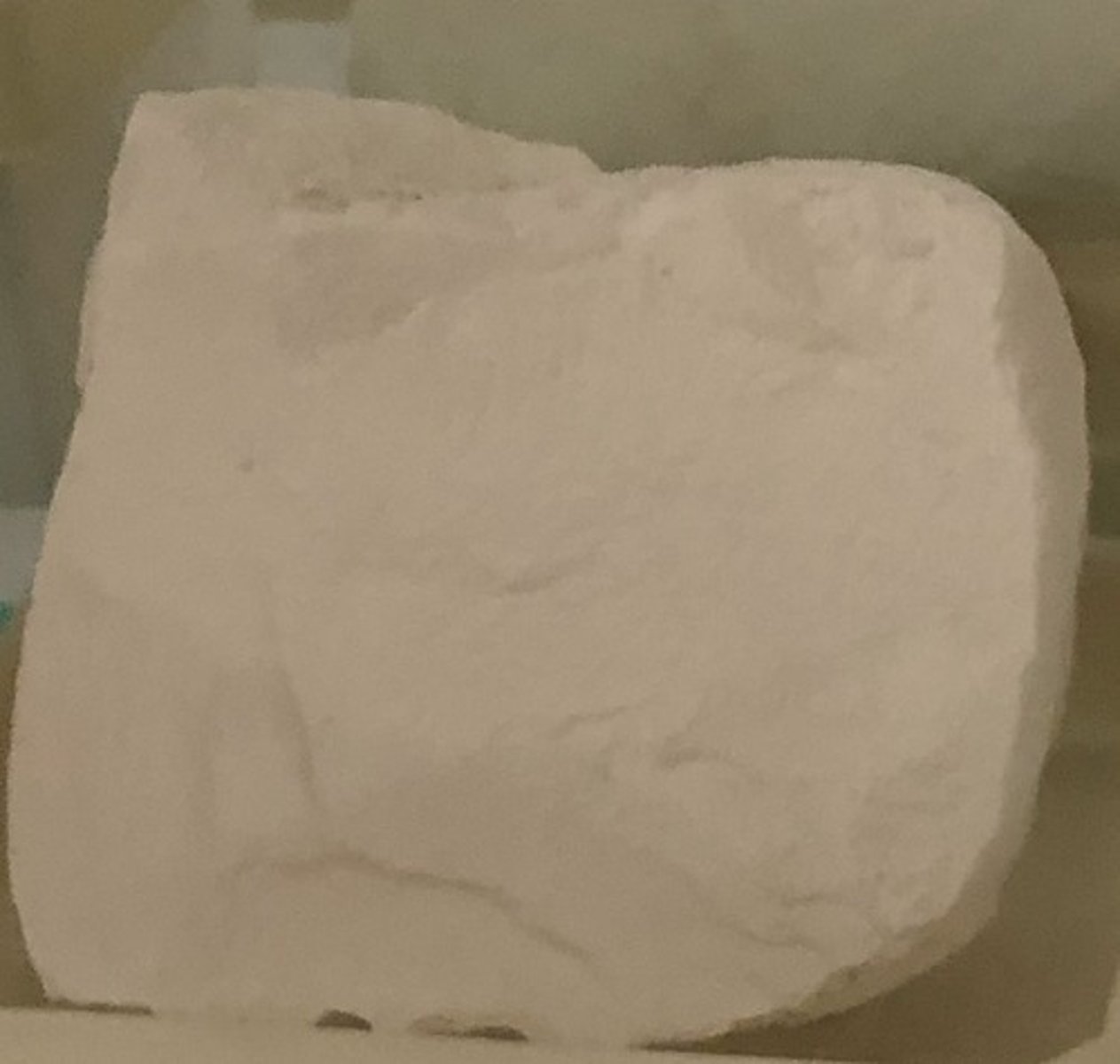
protolith is bituminous coal, texture is nonfoliated, composed of carbon, characterized by black metallic sheen and is homogeneous (no visible grains)
Anthracite Coal
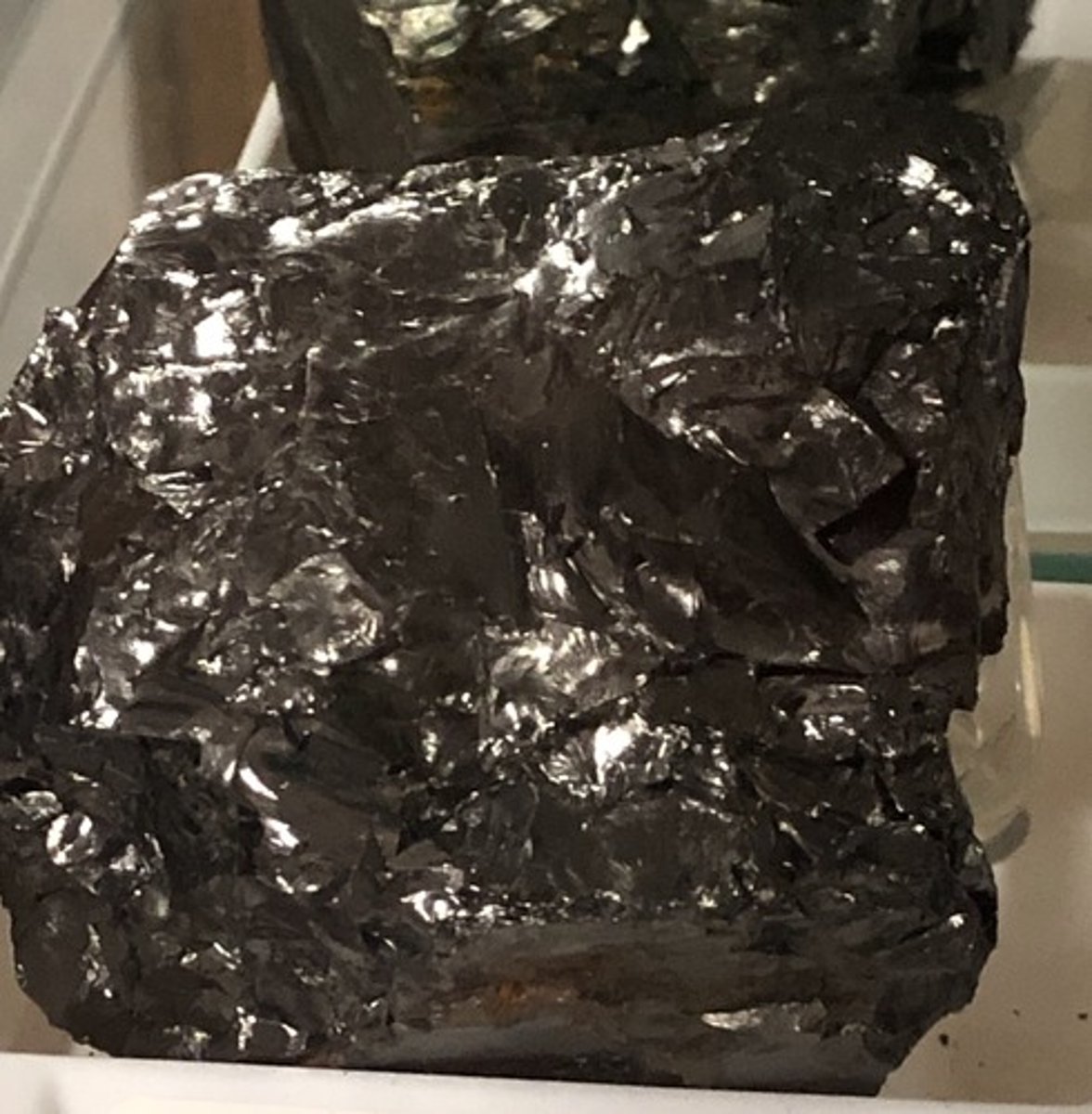
sedimentary, biochemical chemical, composed of mostly calcite, well sorted hash of shell fragments, porous and little visible matrix or cement
Coquina
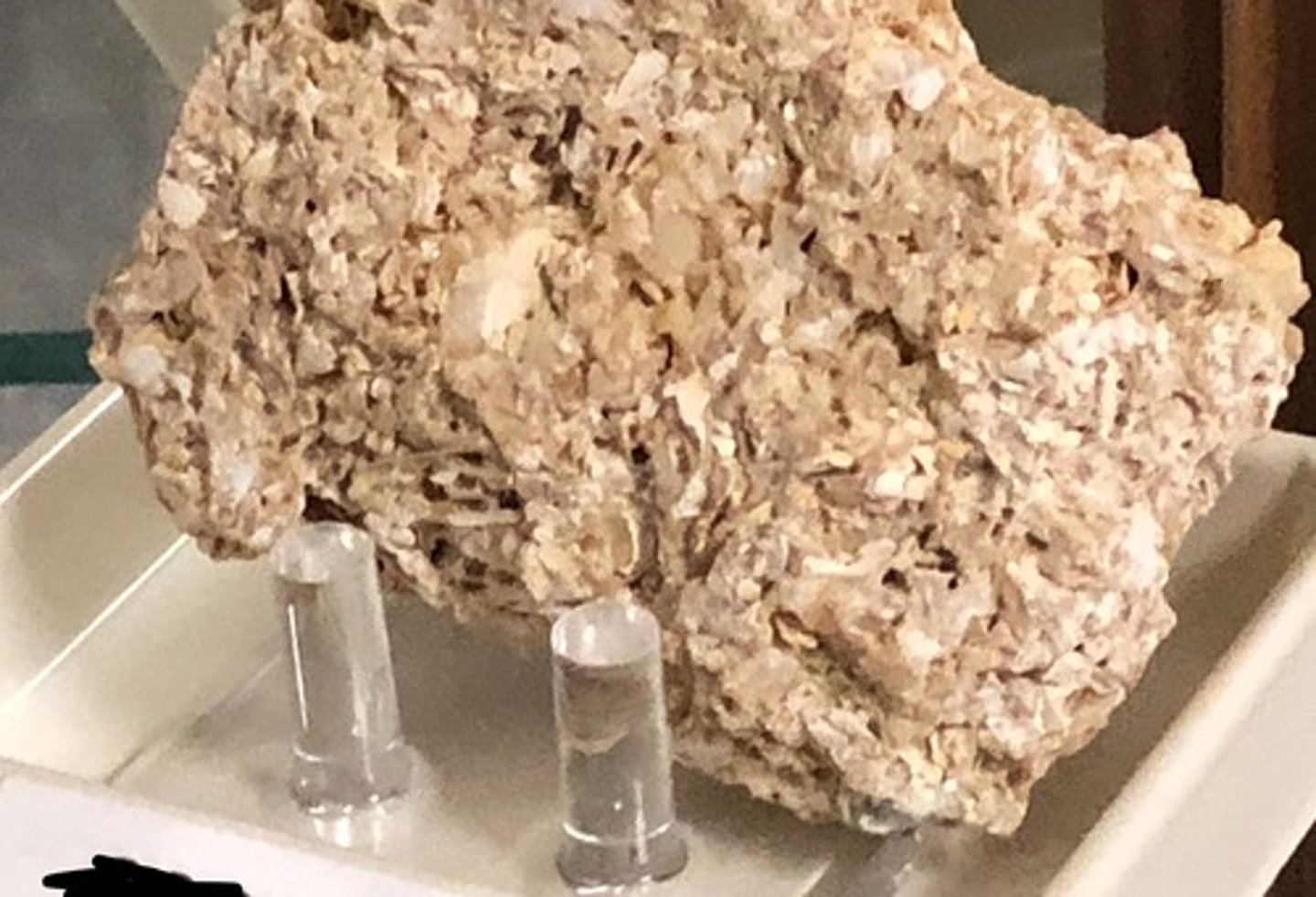
sedimentary, Biochemical chemical, composed of carbonized plant fragments, black to dark brown; brittle, fine bands of dull and shiny coal
bituminous coal
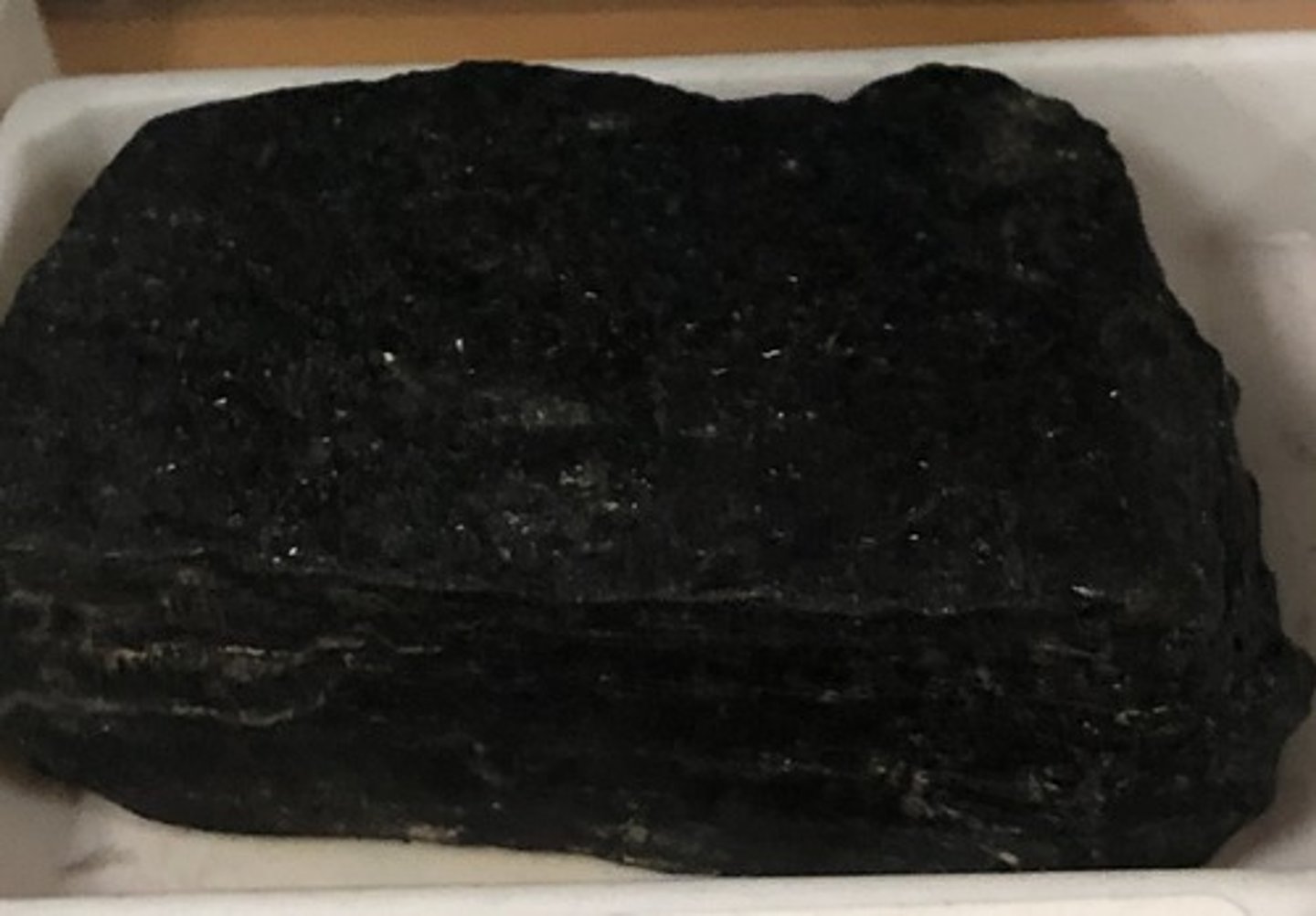
Biochemical chemical, composed of plant fragments, characterized by brown, visible plant fragments, easily fragmented
Peat

inorganic chemical, softer than fingernail and sugary appearance
Rock Gypsum
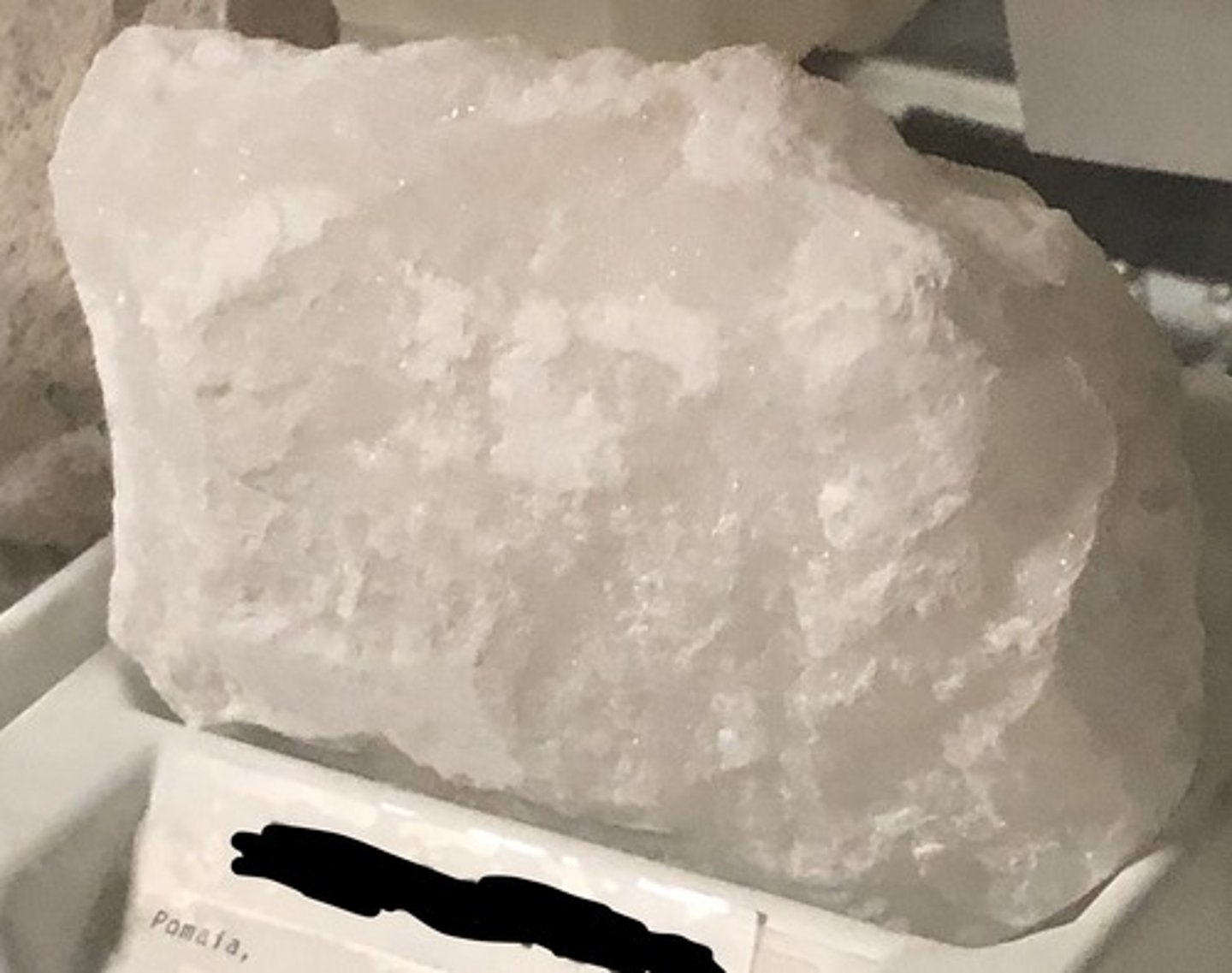
Metamorphism that involves heat, pressure, and shearing, creates foliation
dynamothermal metamorphism
type of metamorphism caused by magma coming into contact with existing rock, does not create foliation
contact metamorphism
type of metamorphism that occurs when very hot water reacts with rock, altering its mineralogy and chemistry
hydrothermal metamorphism
Protolith is shale, Texture is foliated
(Cleavage: slaty)
(main minerals: micas, quartz)
metamorphic grade: lowest foliated
dull luster, breaks into hard flat sheets, rings when tapped by nail
Slate
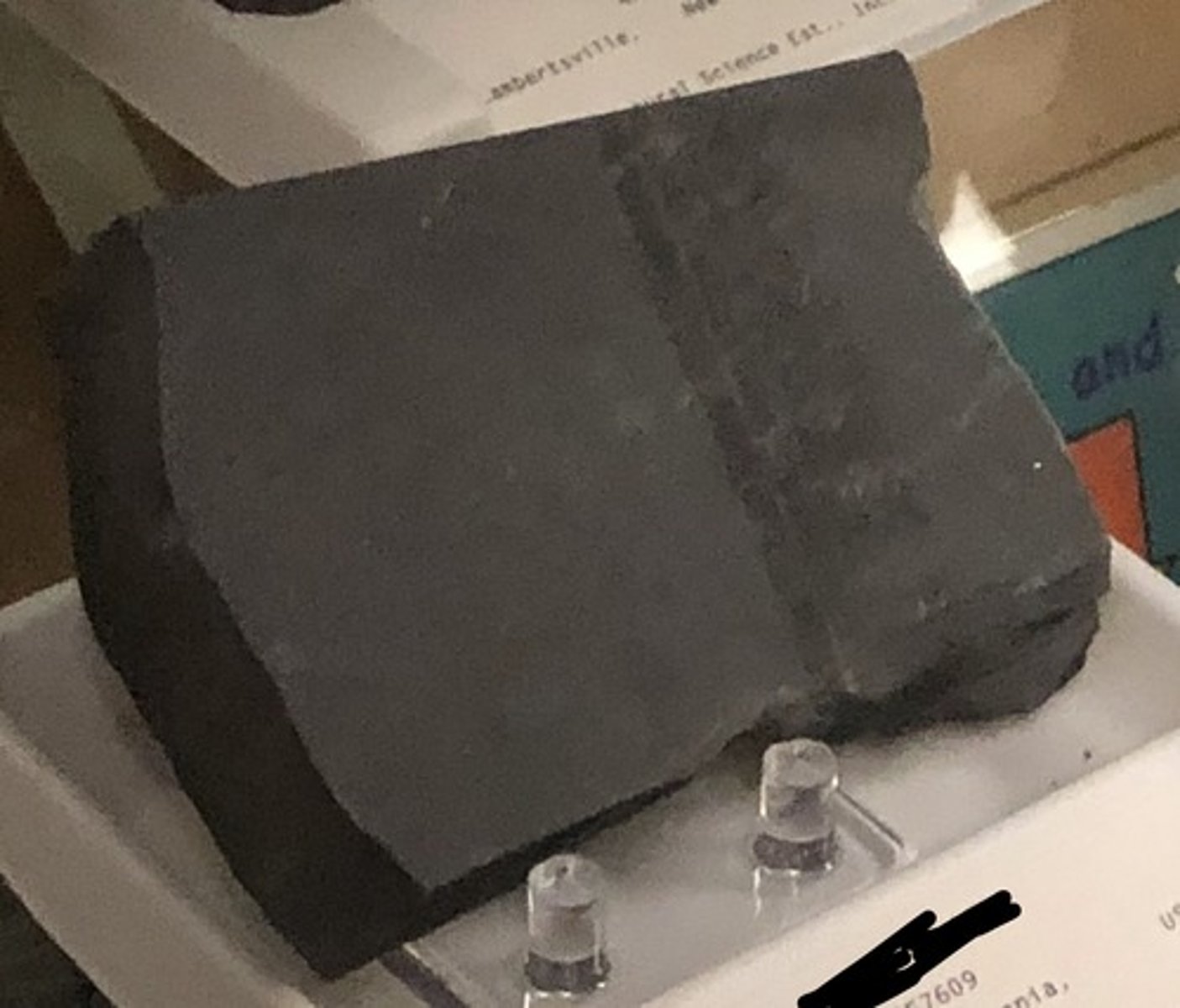
Protolith is shale, Texture is foliated (microscopic crystals)
(main minerals: micas, quartz)
metamorphic grade: second lowest foliated
satiny sheen, breaks along wrinkled or wavy foliation surfaces, small mica minerals barely visible
Phyllite
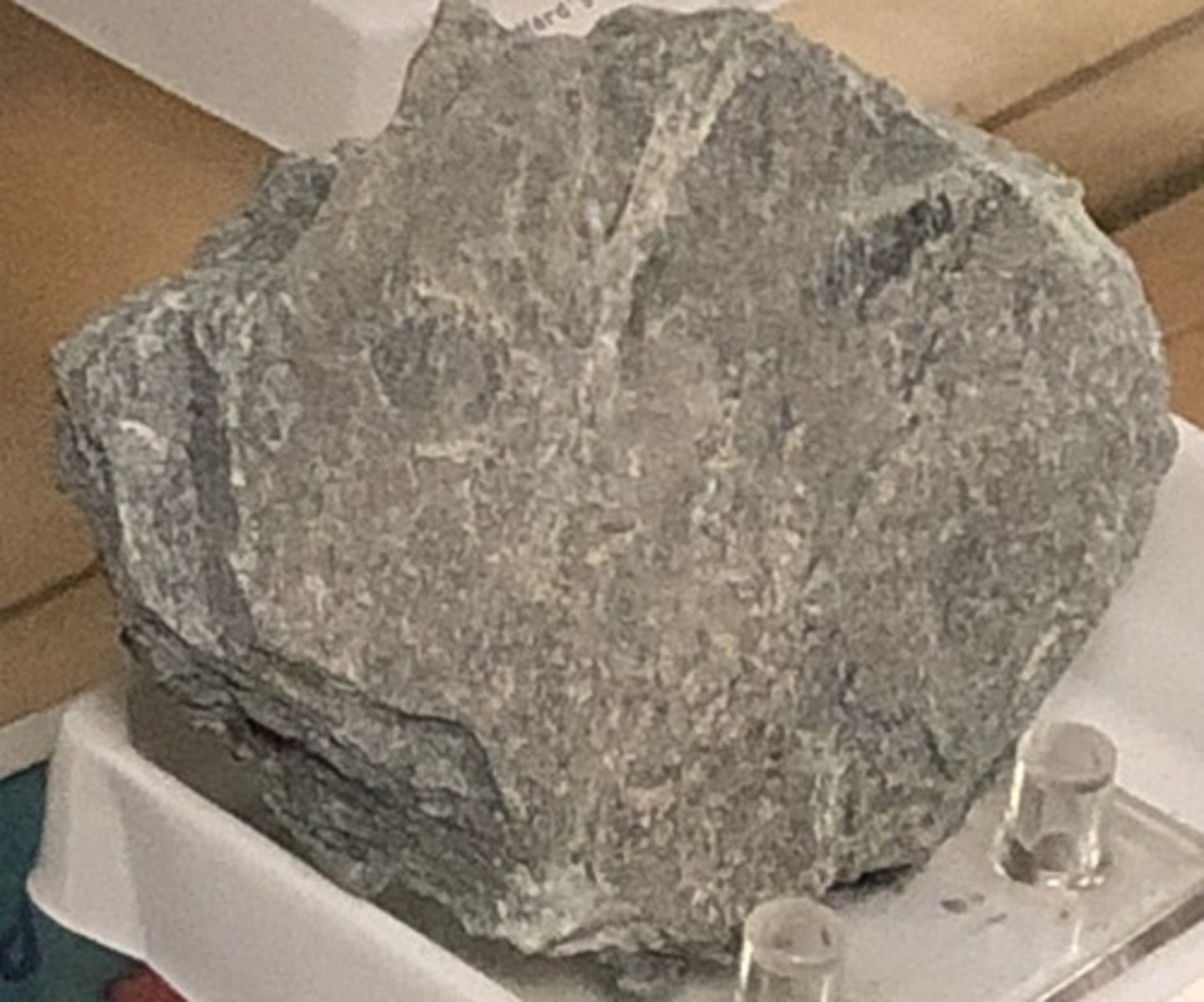
Protolith is shale and granite
Texture is foliated (macroscopic crystals
metamorphic grade: second highest foliated
visible crystals of platy minerals (especially micas), breaks along scaly foliated surfaces, many mineral varieties such as (mica, granite and chlorite)
(brilliant luster, breaks along undulating surfaces, often with porophyoblasts)
Schist

Protolith is is shale and granite (felsic/mafic igneous rocks)
Texture is foliated (macroscopic crystals
(main minerals: micas, quartz, pyroxenes, amphiboles, feldspars)
metamorphic grade: highest foliated
alternating light-dark coloured layers(; contrasting composition)
Gneiss
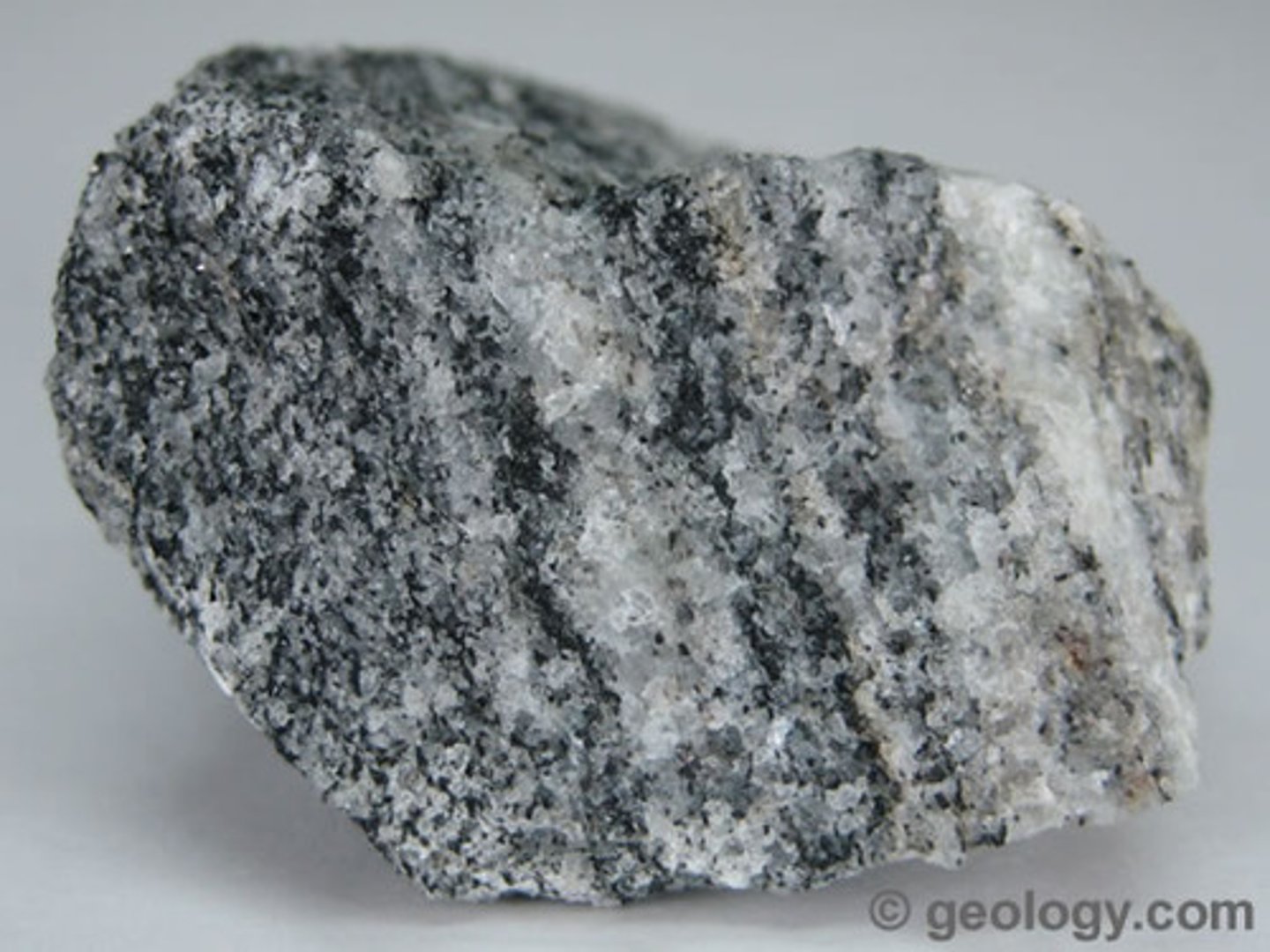
black, two directions of cleavage NOT at 90 degrees, bright reflections off cleavage surface, long slender crystals, splintery fracture, glassy luster, H=5-6
amphibole
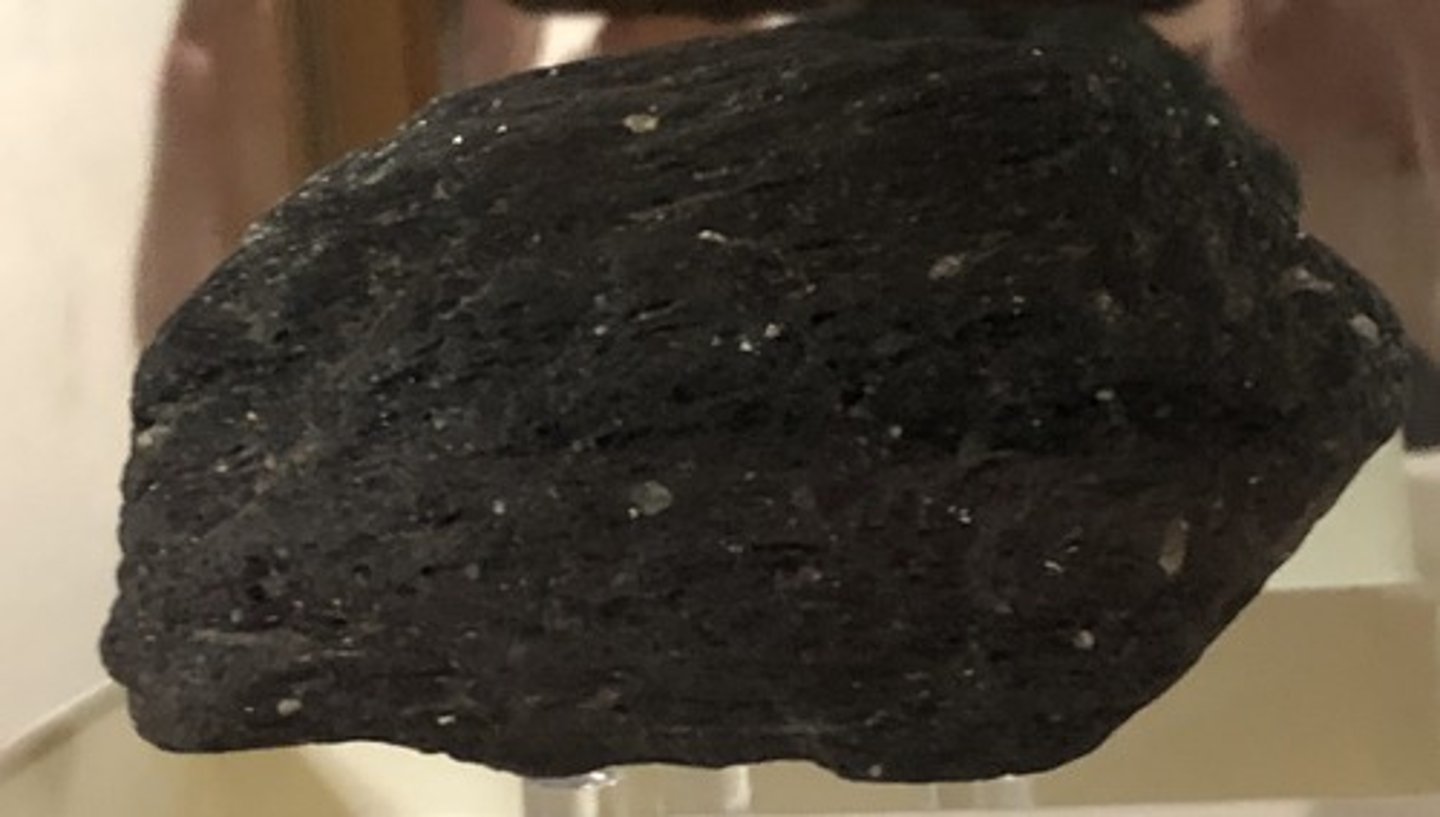
Protolith is quartz sandstone, Texture is nonfoliated (sandy, granular)
(main minerals: quartz)
Quartz sand grains fused together
fine to coarse grained
grains will not rub off like sandstone
harder than glass
quartzite

Protolith is limestone, Texture is nonfoliated (microcrystalline to coarsely crystalline)
(main minerals: calcite, dolomite)
fused calcite crystals, reacts to acid, softer than glass, coarse grained, color variable
Marble

Protolith is basalt(mafic to ultramafic igneous rocks)
Texture is nonfoliated (finely crystalline to fibrous)
dark with dull to waxy luster, has greenish bladed crystals with glossy or waxy luster, is fine to coarse grained
Serpentinite

Protolith is many possible but shale is common (any fine-grained rock adjacent to igneous intrusion)
Texture is nonfoliated (randomly oriented, porphyroblastic-large mineral crystal in a metamorphic rock which has grown within the finer grained groundmass)
dark gray, green to black, microcrystalline to fine grained, but may contain larger crystals of specific minerals, mat luster, dense, very hard
Hornfels
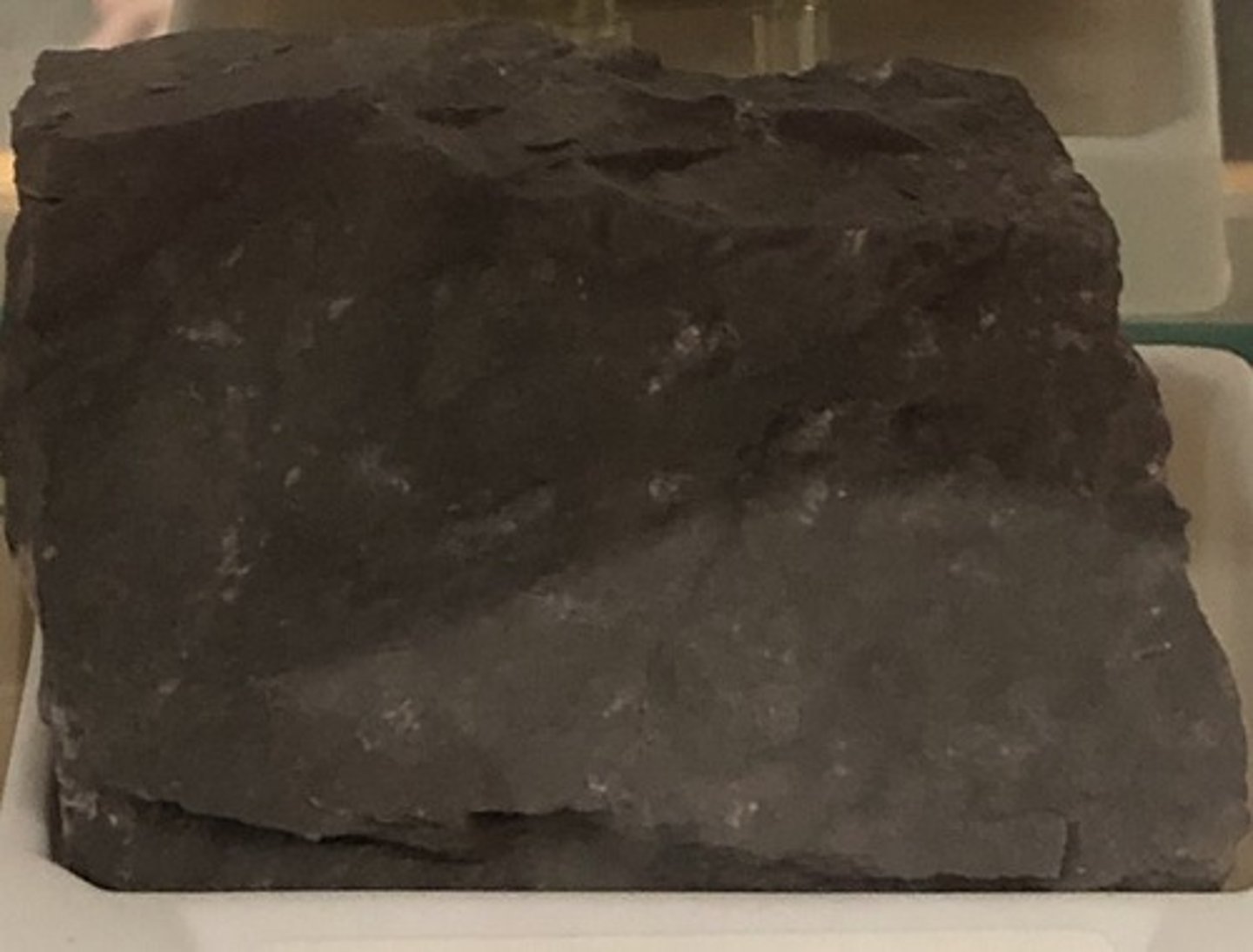
vesicular, mafic, extrusive, pyroclastic texture
Vesicular Basalt

Brown to greenish black to black
Perfect cleavage in one direction (basal/sheet)
Glassy luster
Elastic
H= 2.5-3
Biotite Mica
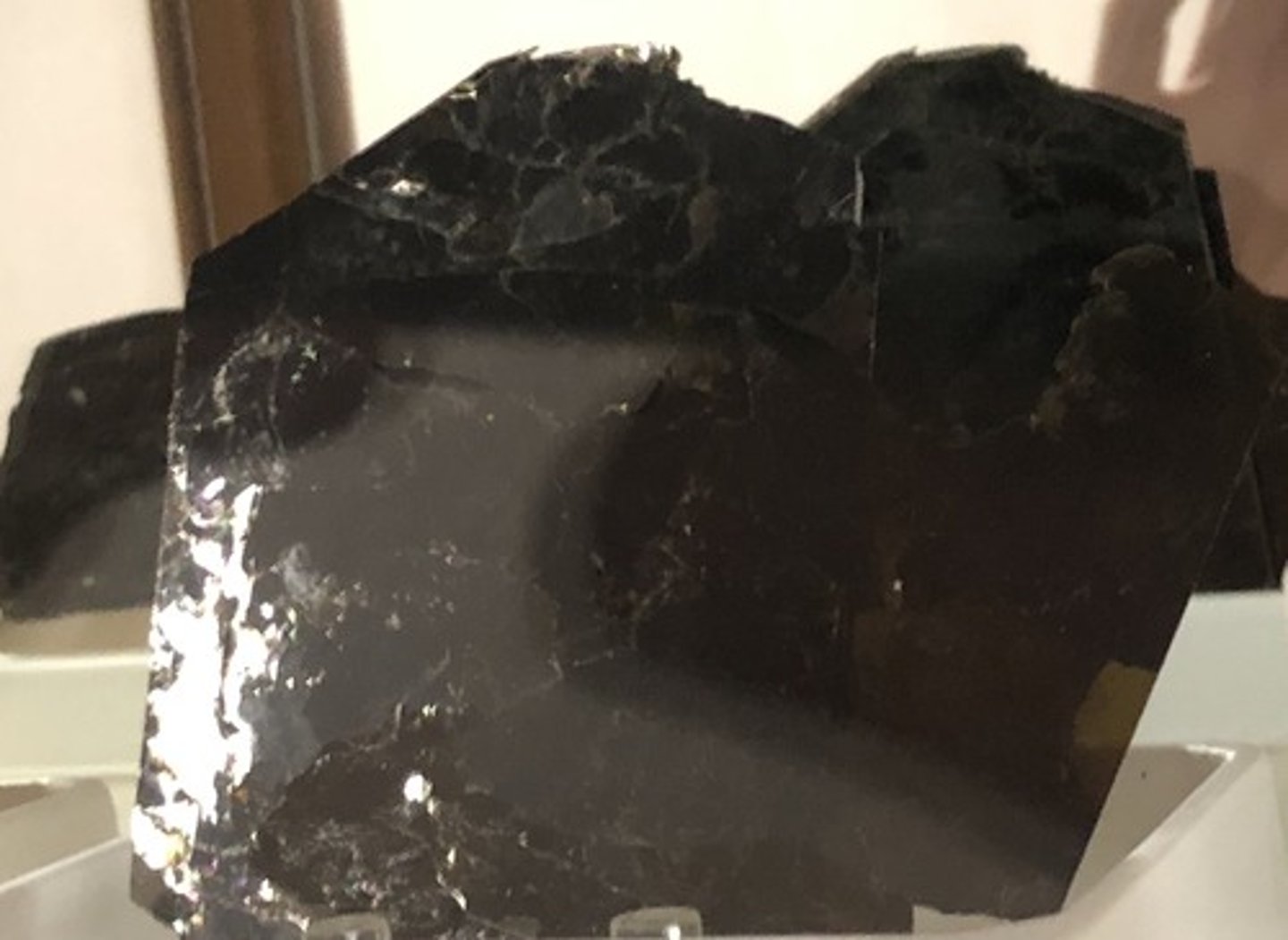
Colorless to white, yellow, pink, blue, to gray or brown
3 direction of cleavage NOT at 90 degrees (rhombic)
Glassy luster
Fizzes with HCL acid
Double refraction
H= 3
Calcite
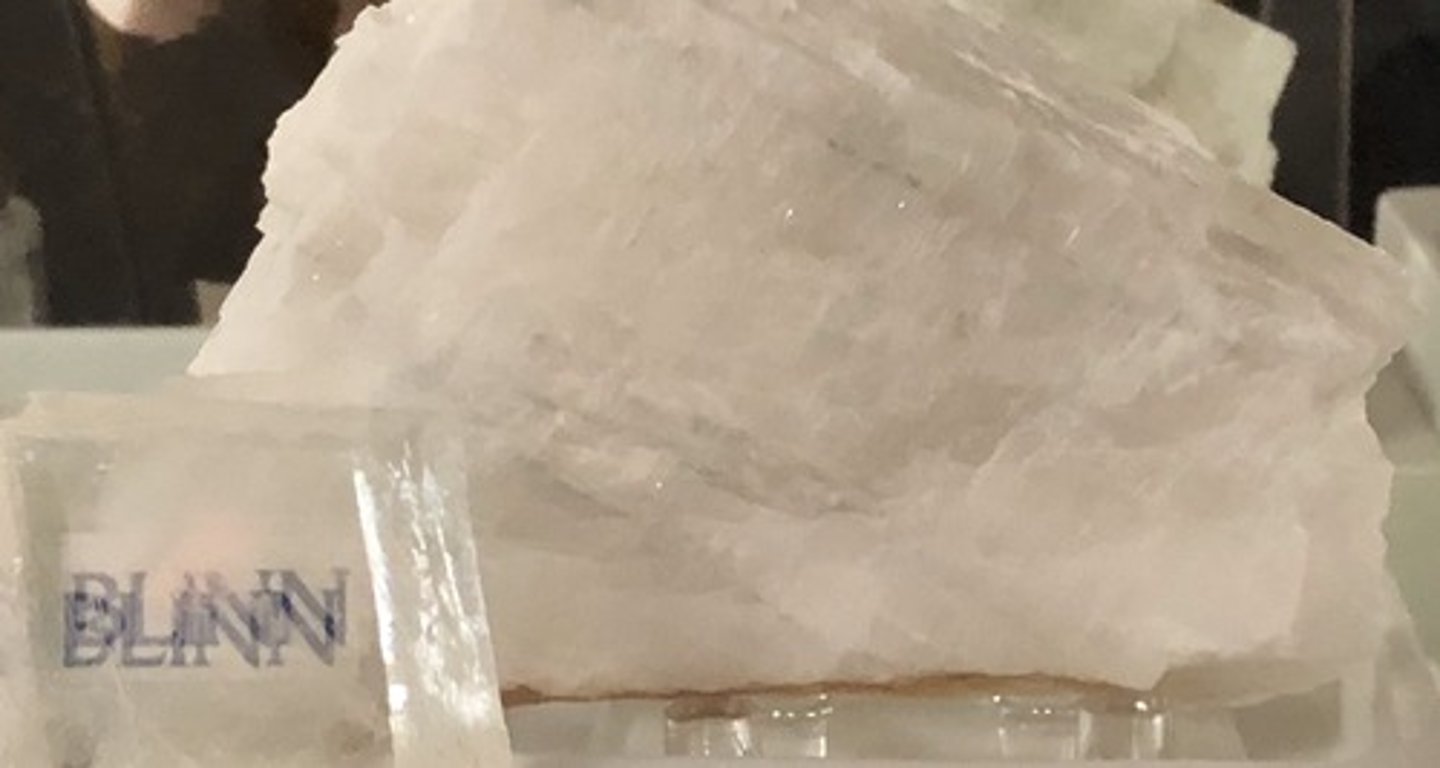
Copper streak
Copper color
tarnishes brown or green
forms odd shaped masses
no cleavage
H= 2.5-3
Copper

Usually rusty gray, dull luster, rarely blue (sapphire) or red (ruby) forms 6 sided crystal, H=9
corundum
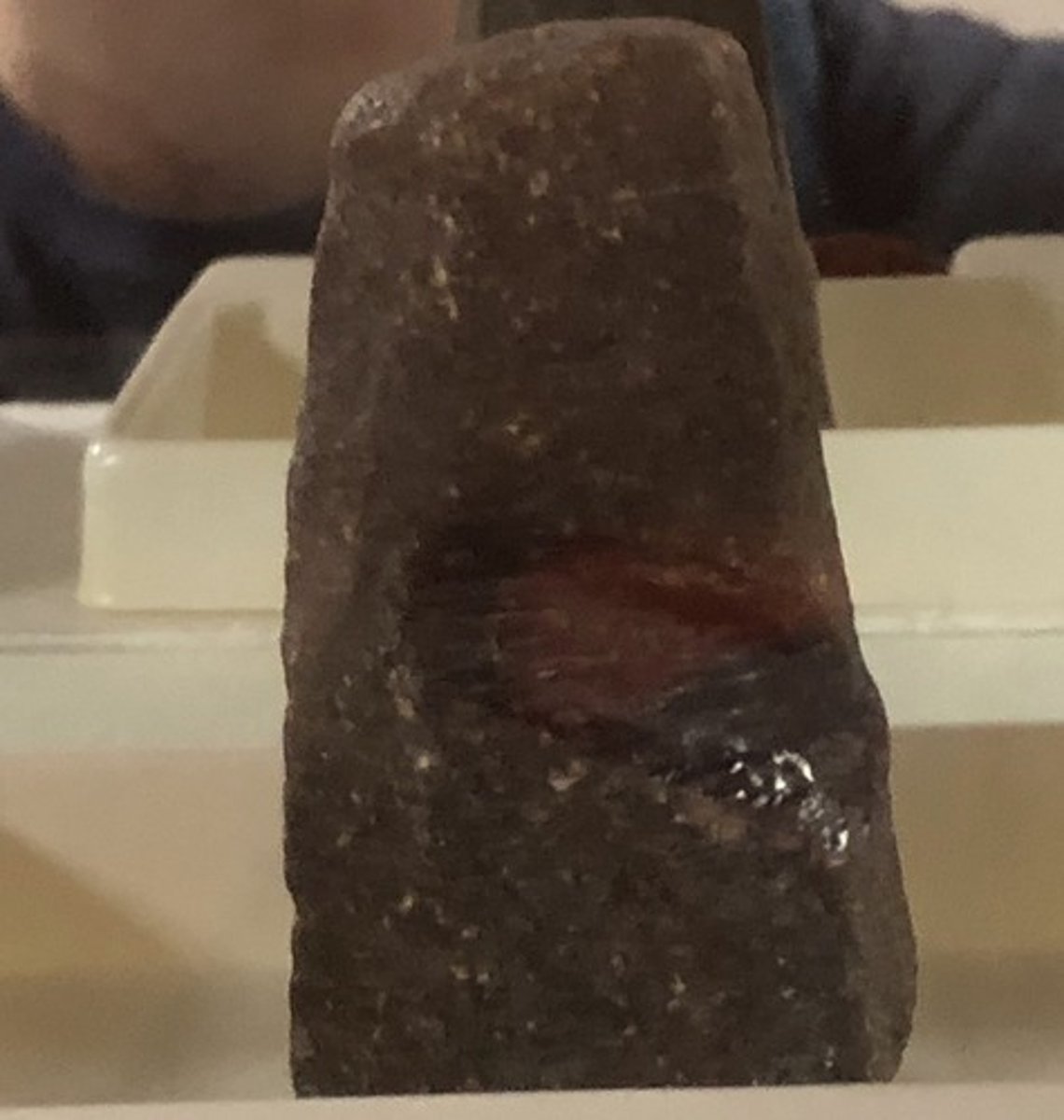
Purple, green, clear and many other colors
Translucent or transparent
Cubic crystals
4 directions of cleavage (octahedral)
Glassy luster
H= 4
Fluorite
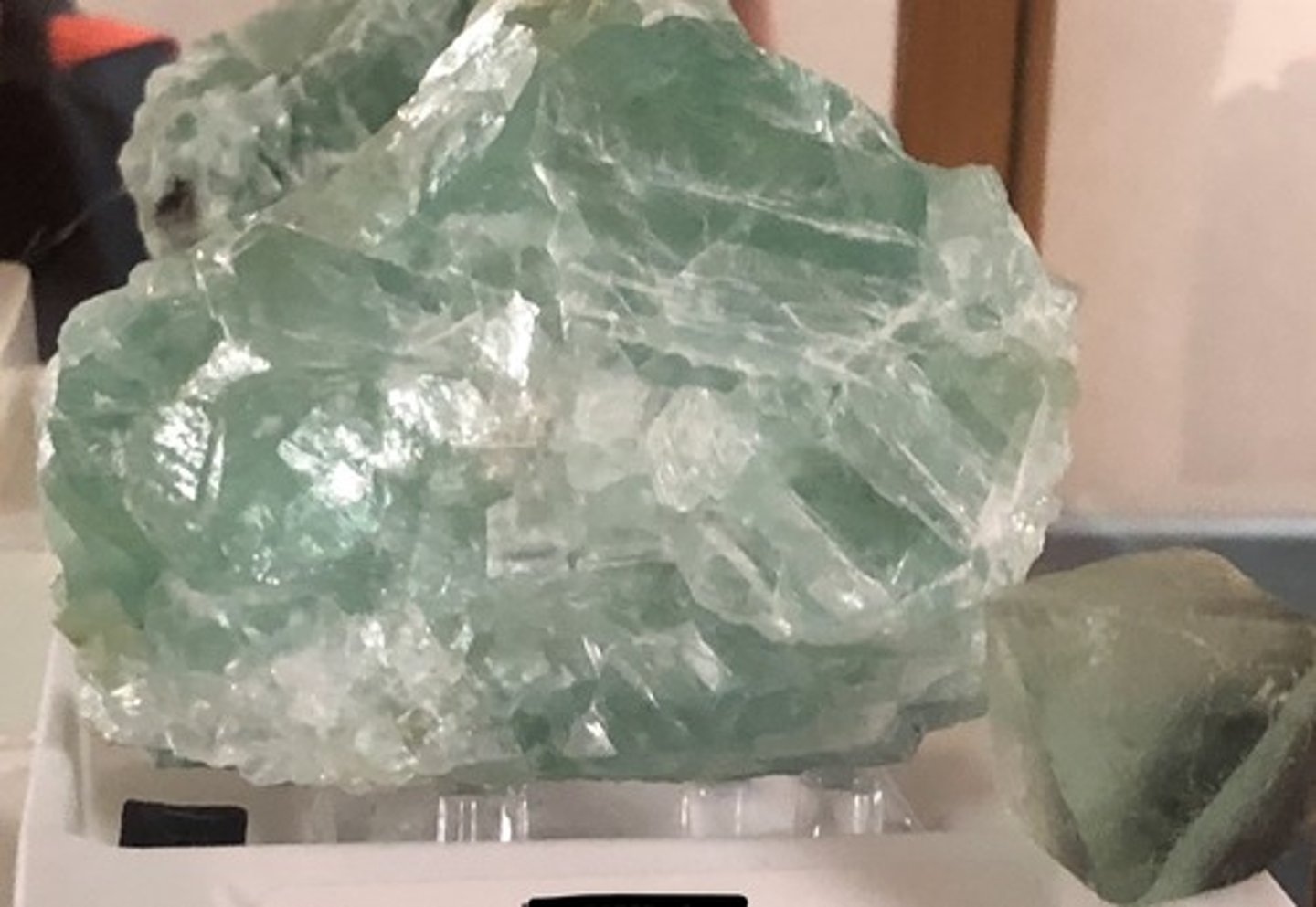
Dark gray streak
Silver to lead gray
Cleavage in 3 directions at 90 degrees (cubic)
Dense
H= 2.5
Galena
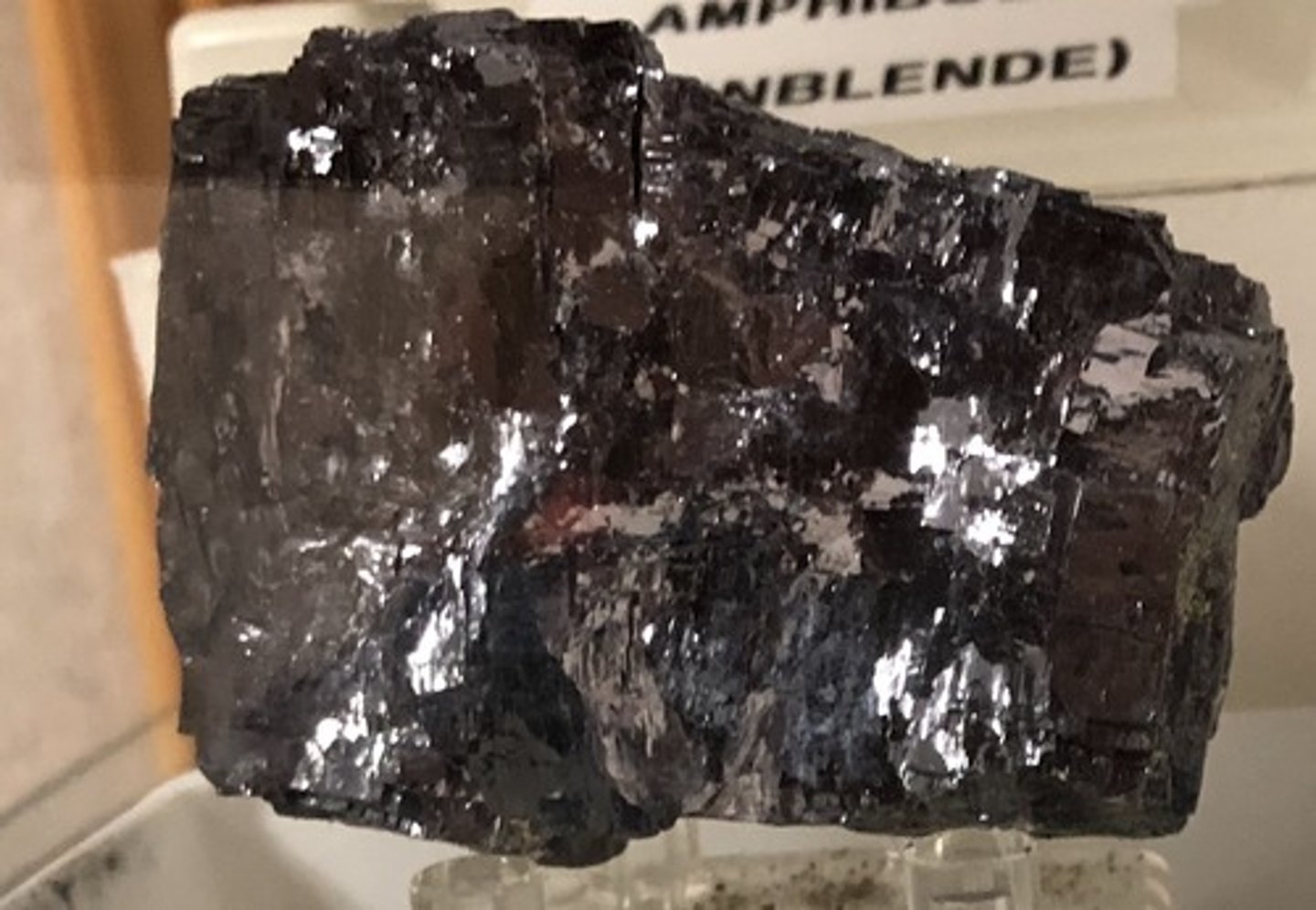
Colorless to white
Cleavage good in one direction, poor in two others
Satiny luster
H= 2
Gypsum
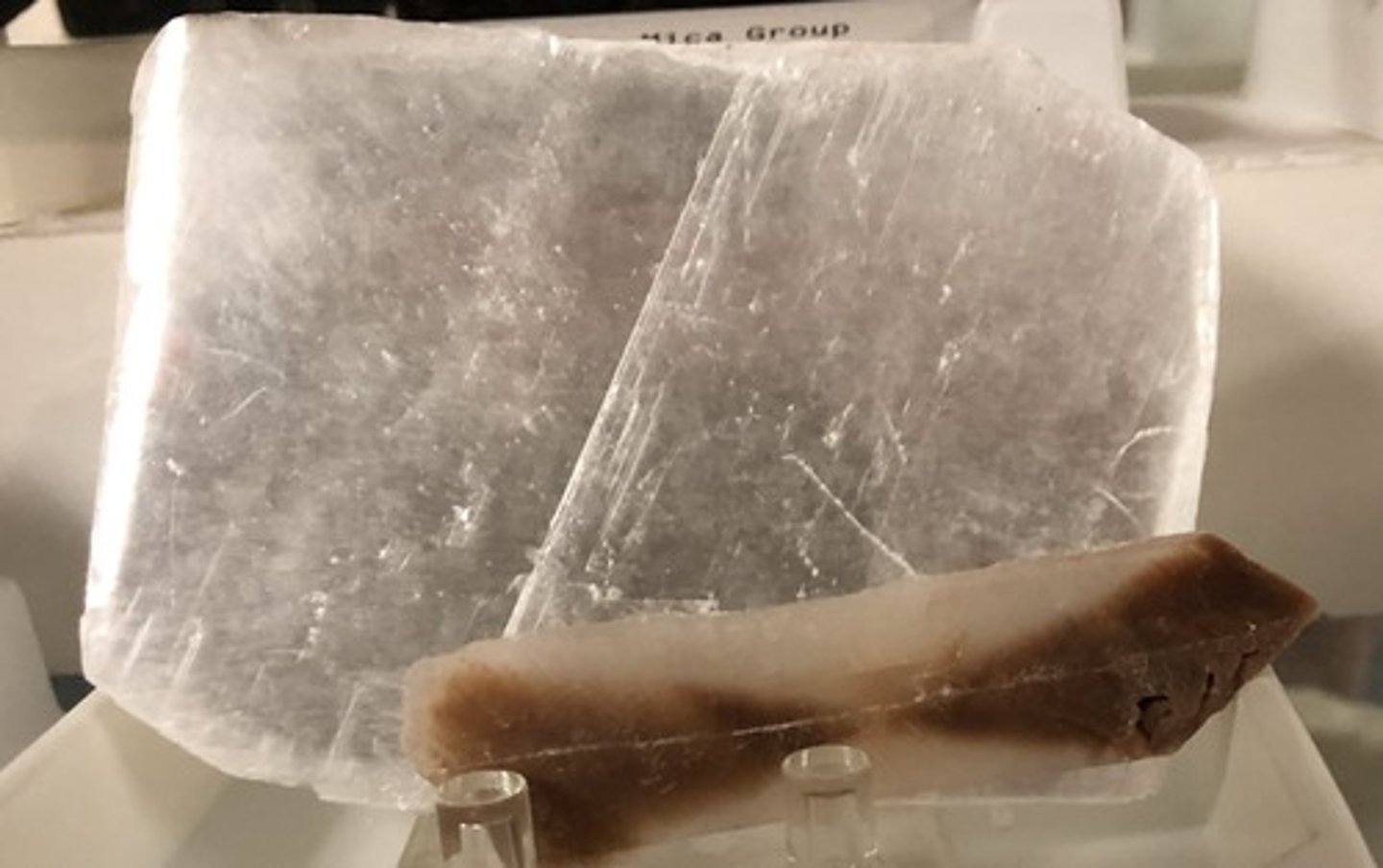
Usually colorless to white (may be many colors)
Cleavage in three directions at 90 degrees (cubic)
Glassy luster
Salty taste
H= 2.5
Halite

Reddish-brown streak
Silver to steel gray in color
Uneven fracture
Glitter-like flakes
H= 5-6
Hematite (specular)
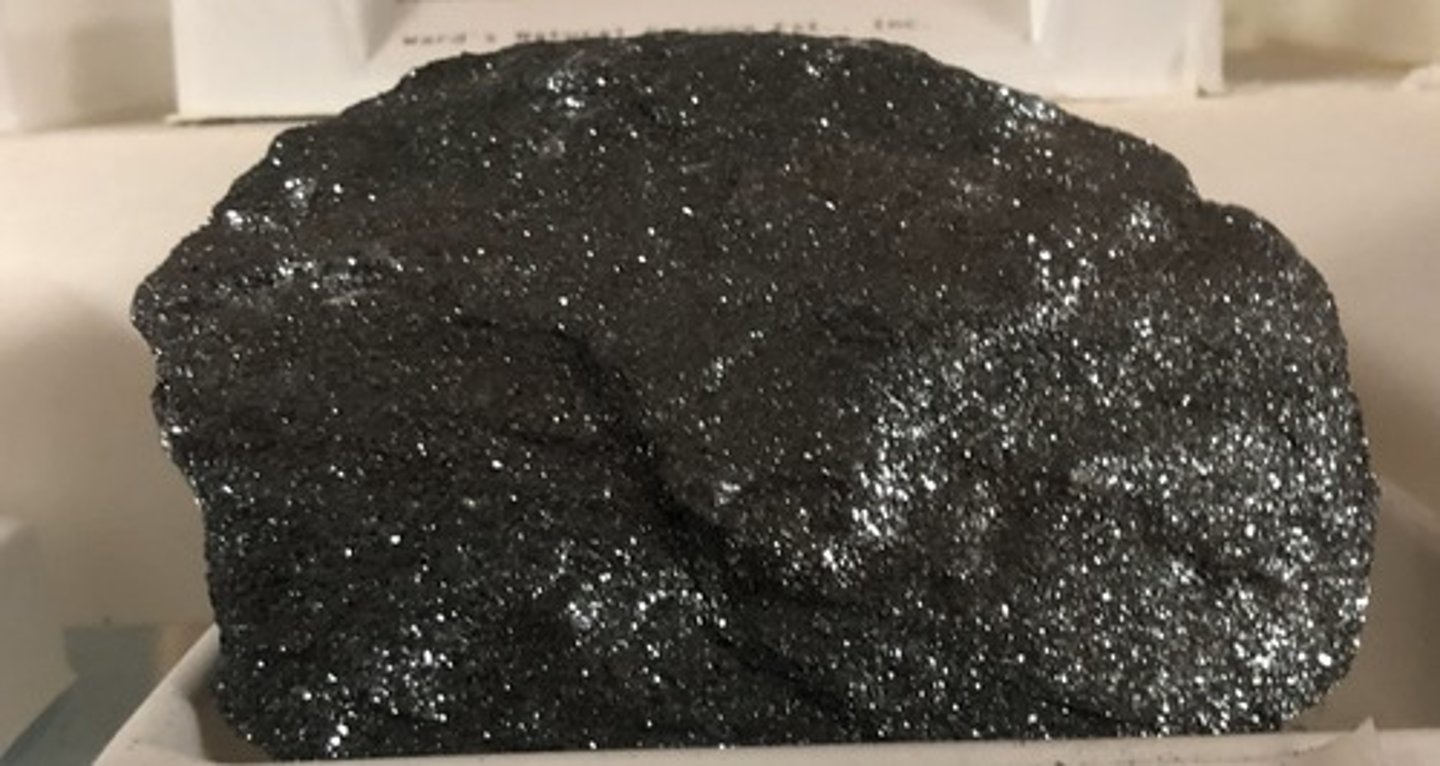
Red to reddish brown, dull/earthy luster, reddish brown streak, H=1.5-3
Hematite (earthy)
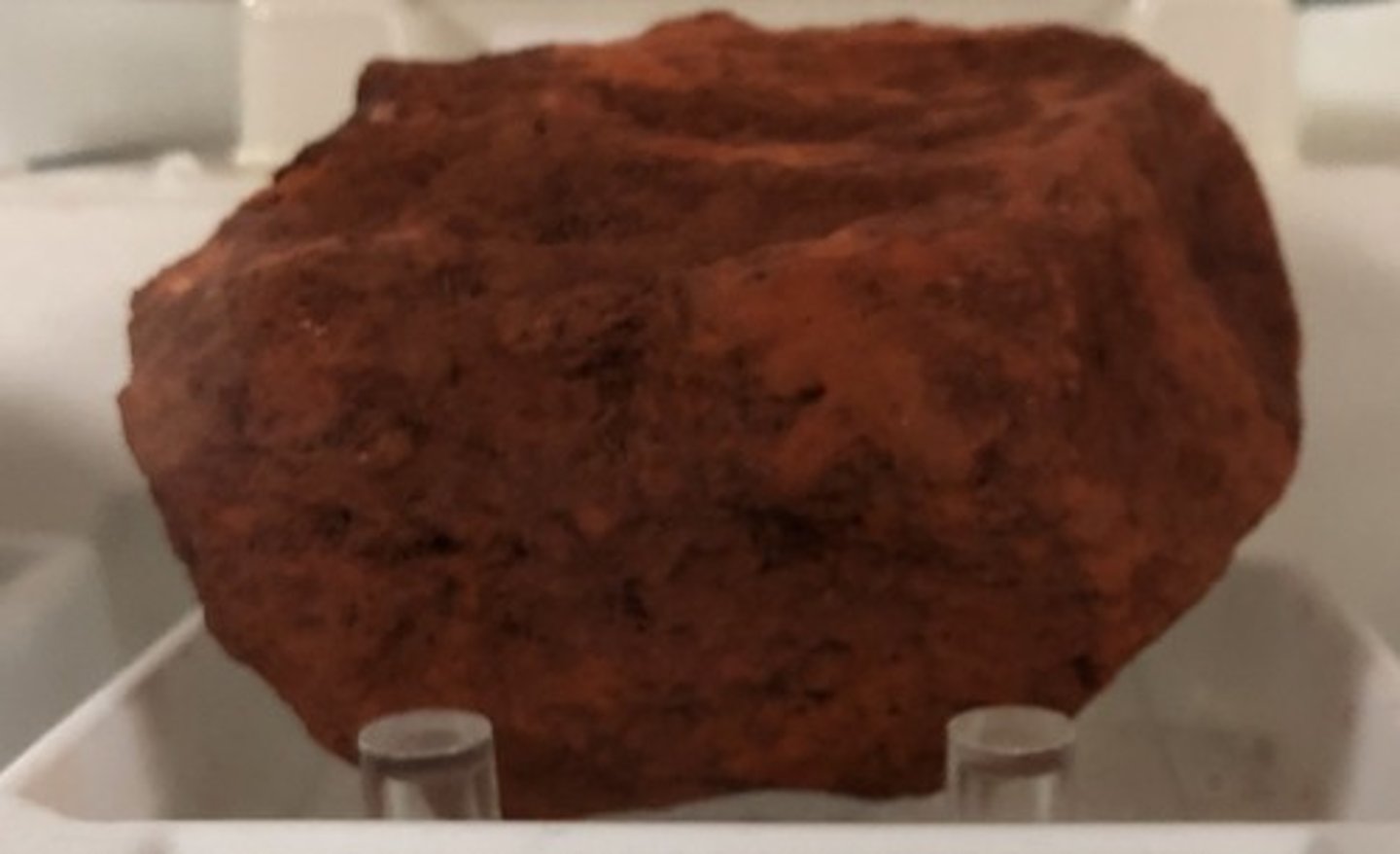
white, dull luster, occurs in powdery masses, earthy smell, H=2-2.5
Kaolinite
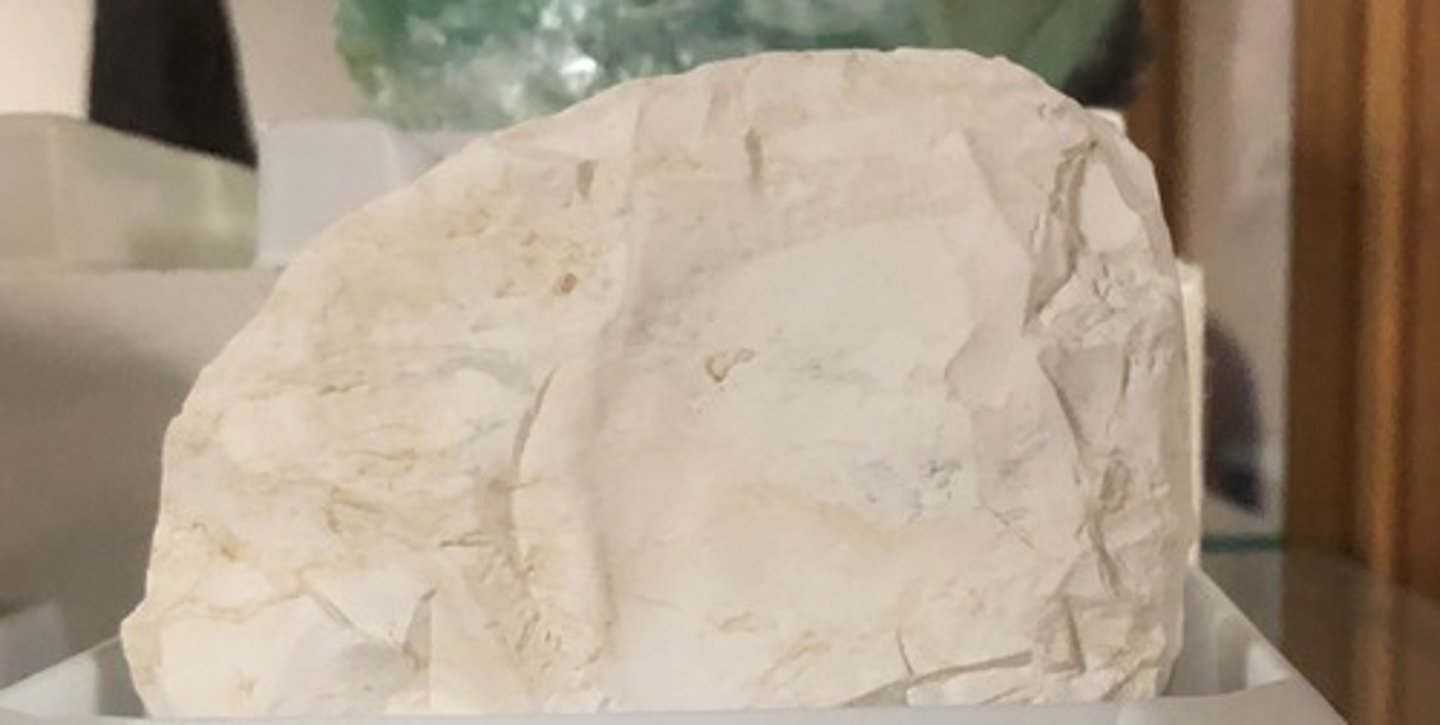
Yellow to yellowish brown
Dull/earthy luster
Rusty smell
Yellowish brown streak
H= 1.5-5.5
limonite
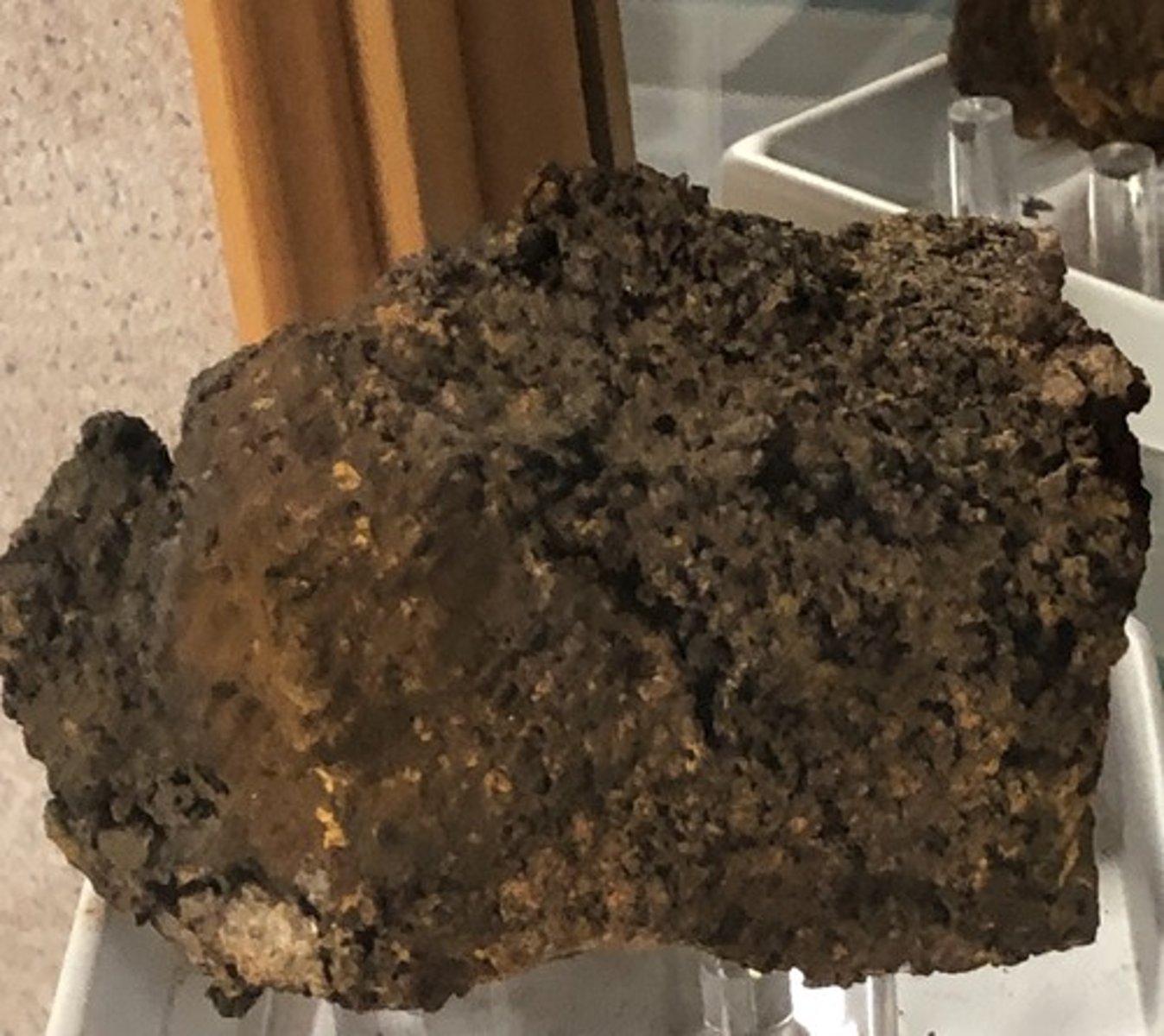
Black streak
Black to dark gray in color
Crystalline masses
Uneven fracture
Dense
Magnetic
H= 5.5-6.5
Magnetite
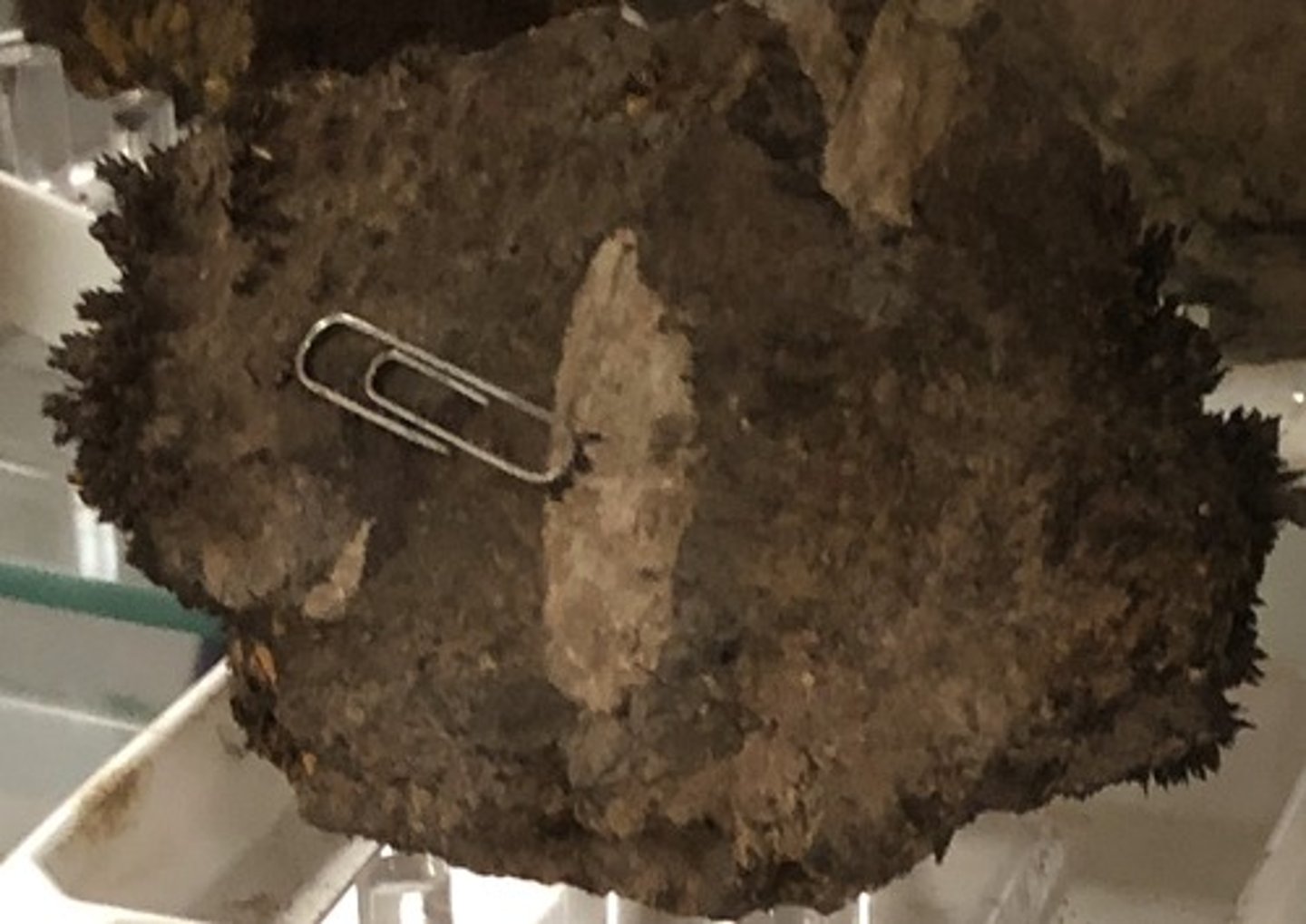
colorless to light tan, perfect cleavage in one direction (basal/sheet) transparent in thin sheets, glassy luster, elastic, H=2.5-4
Muscovite Mica
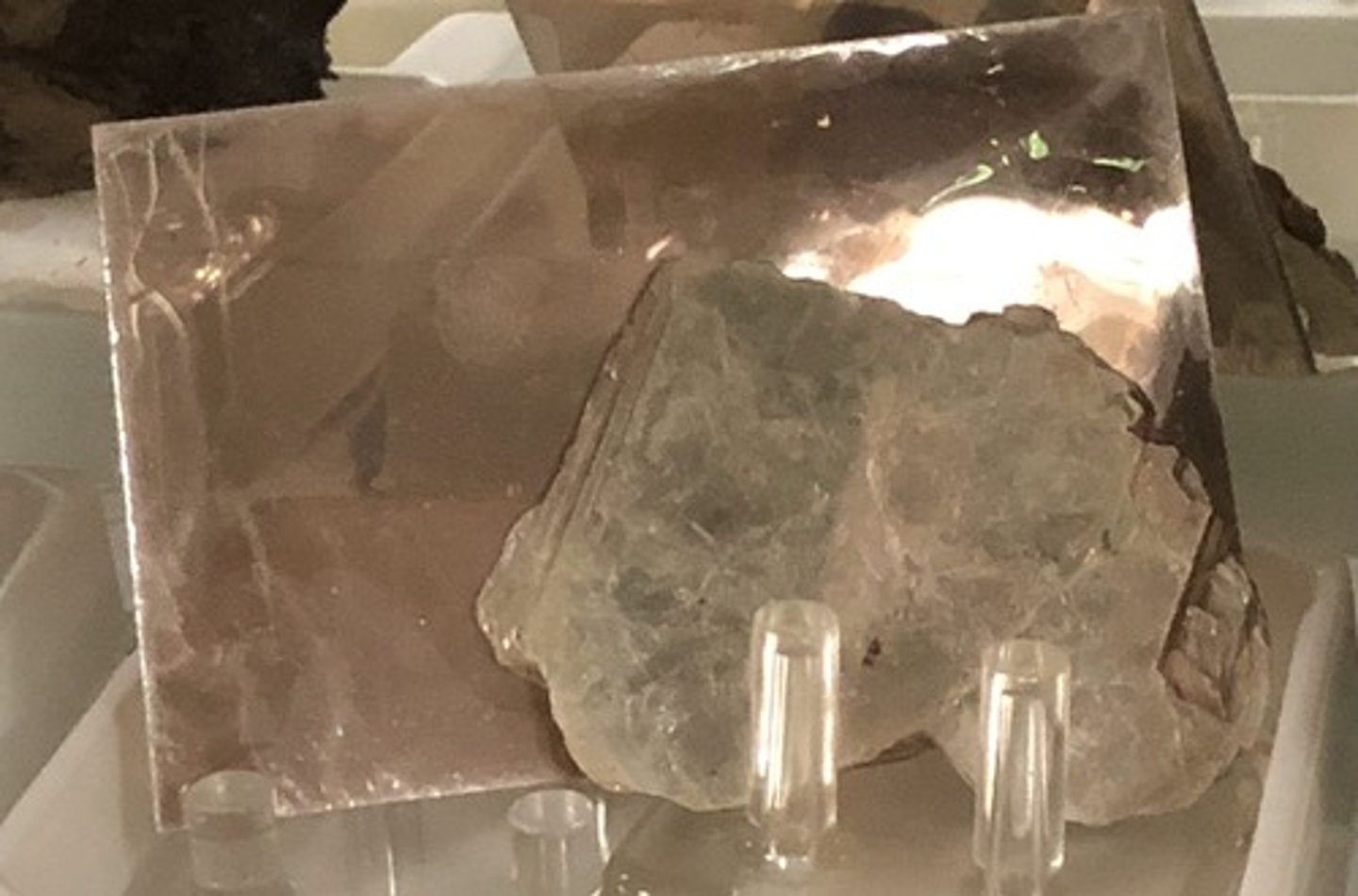
light to dark green, small granular grains, single crystals rare, glassy luster, conchoidal and uneven fracture, H=6.5-7
olivine
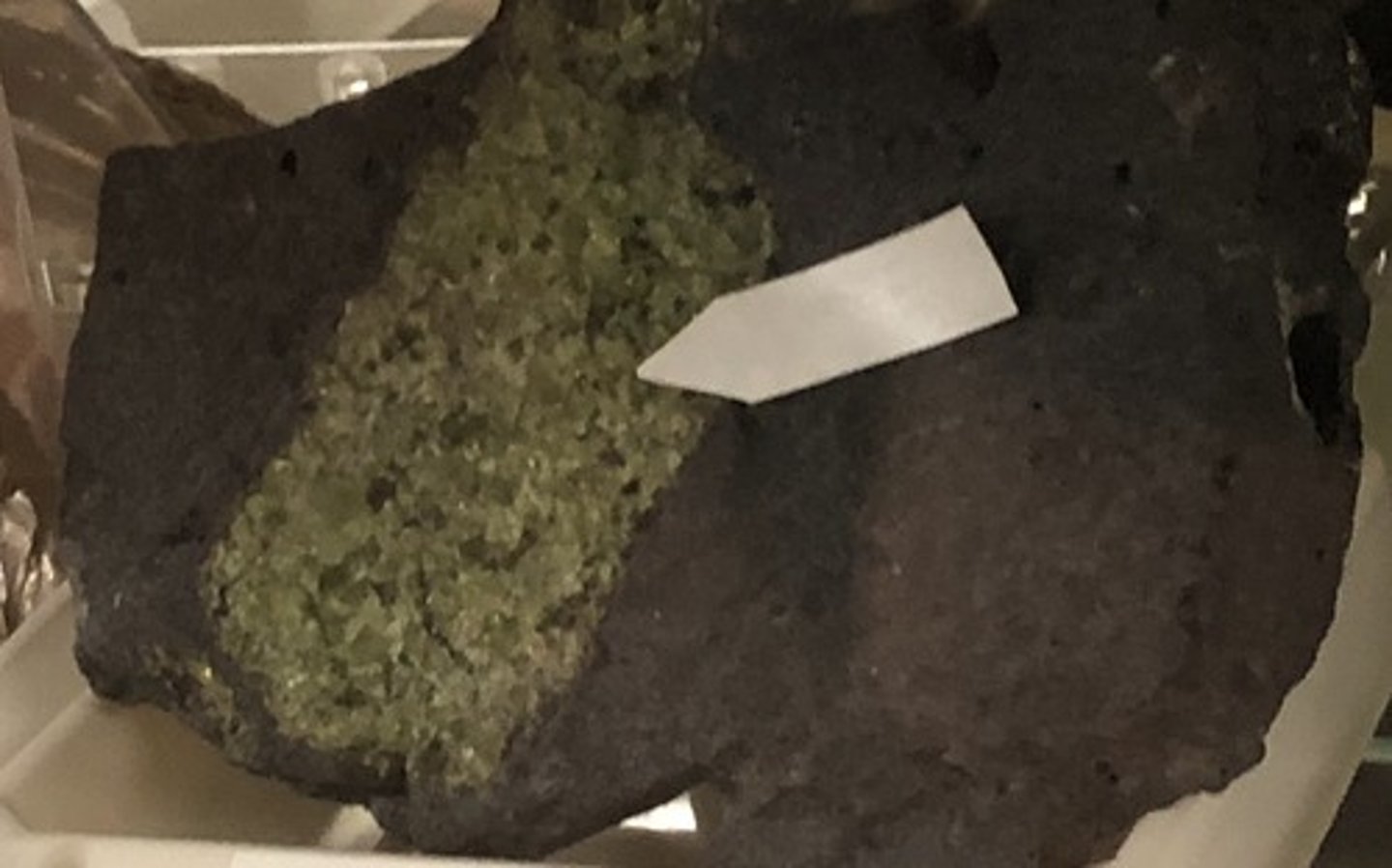
white to dark gray, two directions of cleavage at 90 degrees, striations common, usually on one cleavage face, glassy luster, white streak, H=6-6.5
plagioclase feldspar
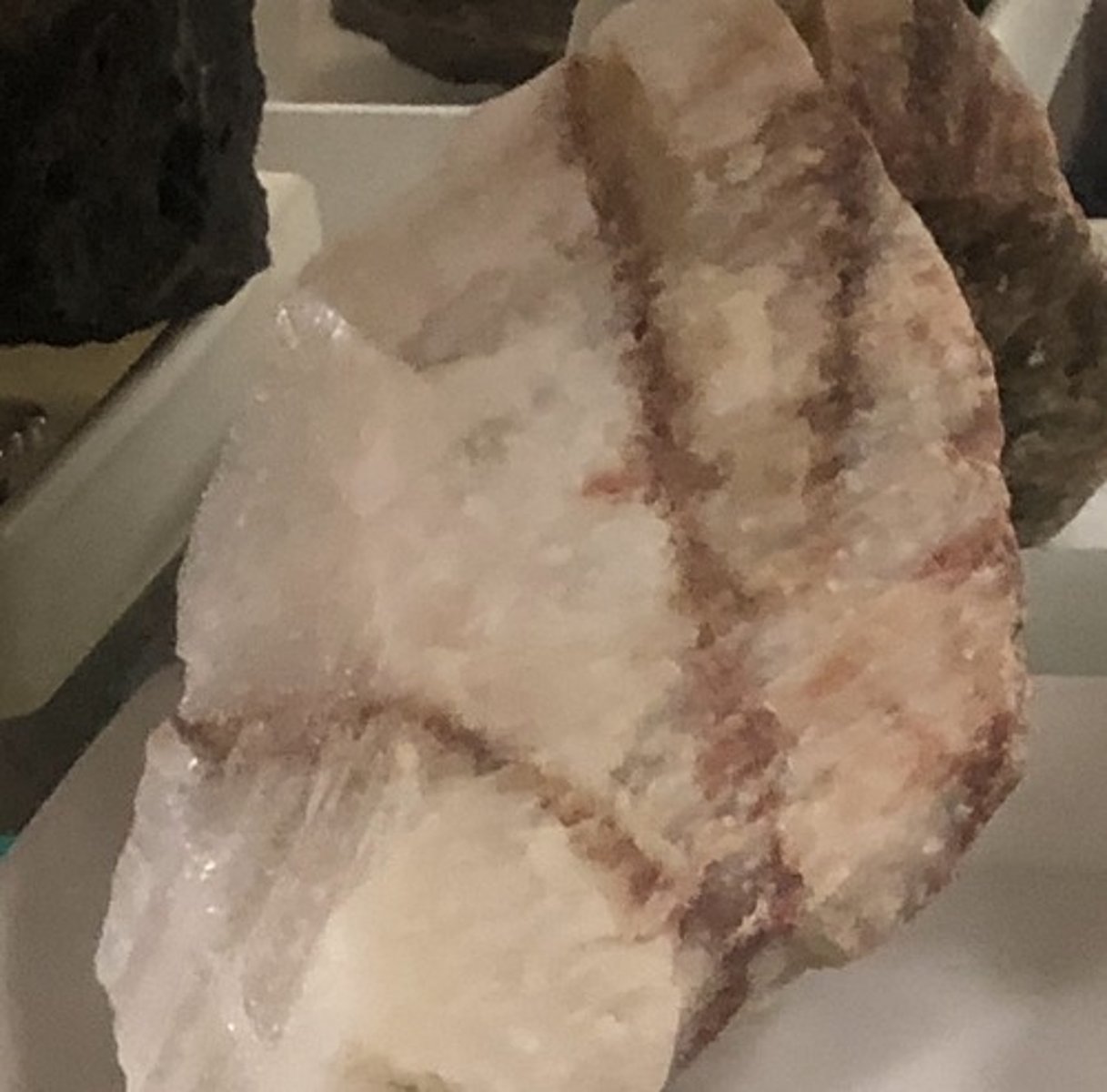
Pink, white or green
Two direction of cleavage at 90 degrees
Exsolution lamellae common
Glassy luster
H= 6-6.5
potassium feldspar
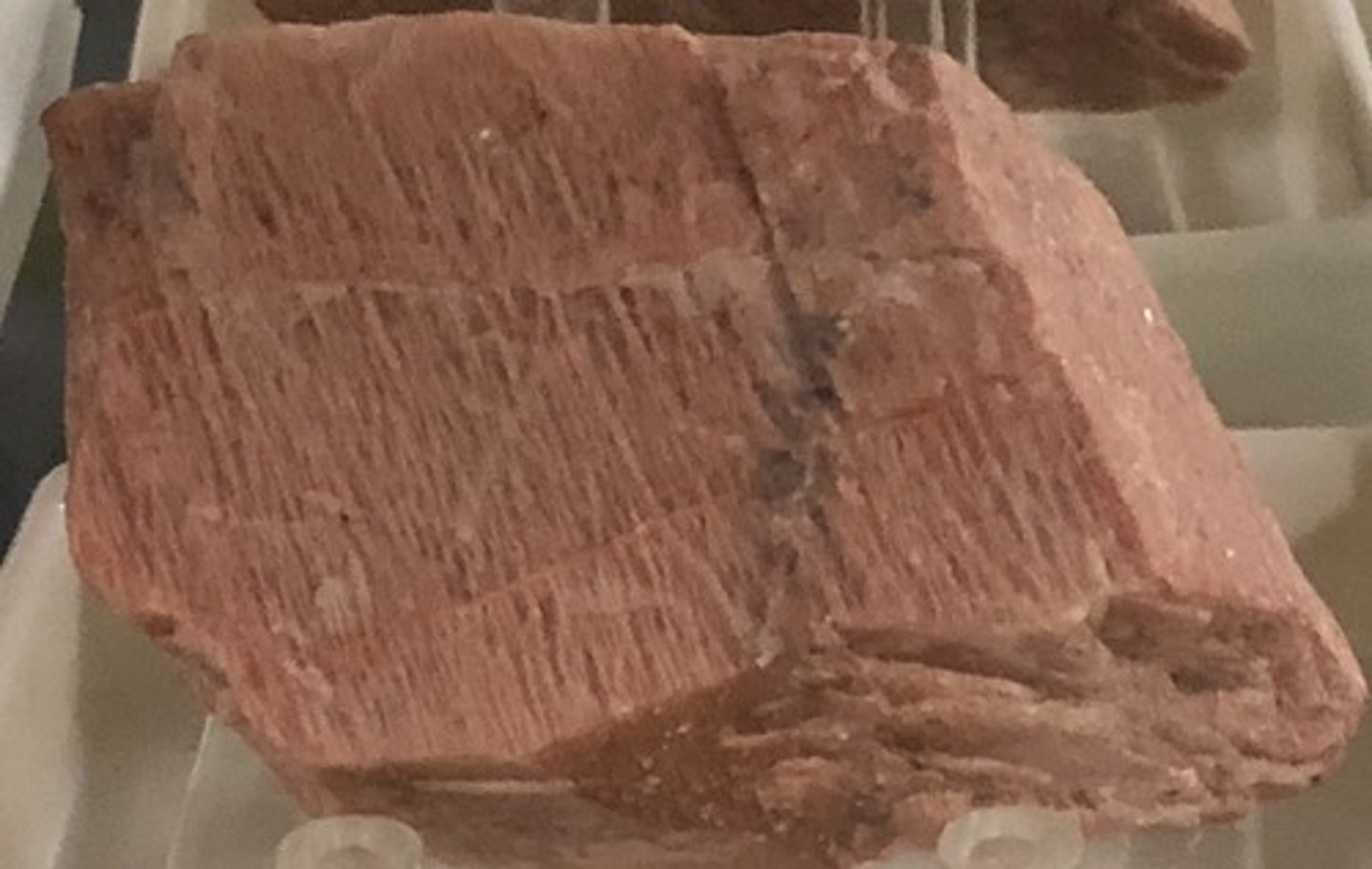
Greenish-black streak
Crystalline masses or cubic crystal form
No cleavage
"Fools gold"
H= 6-6.5
pyrite
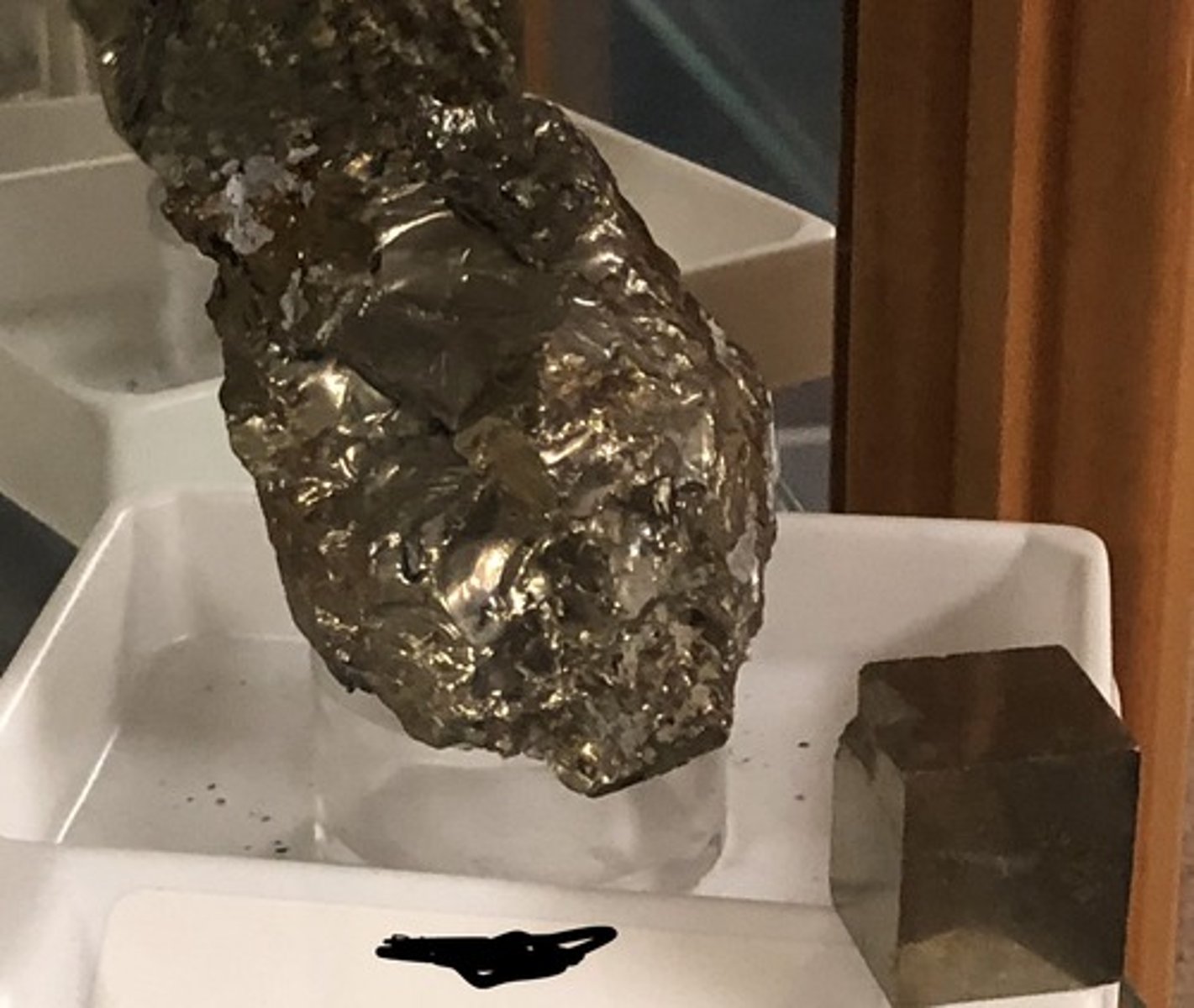
greenish black to black, two directions of cleavage at 90 degrees, dull to glassy luster, H=5.5-6
pyroxene (variety augite)

many color variations, occurs as crystallized masses or 6 sided single crystal forms (hexagonal pyramids and prisms) glassy luster, conchoidal fracture, H=7
quartz
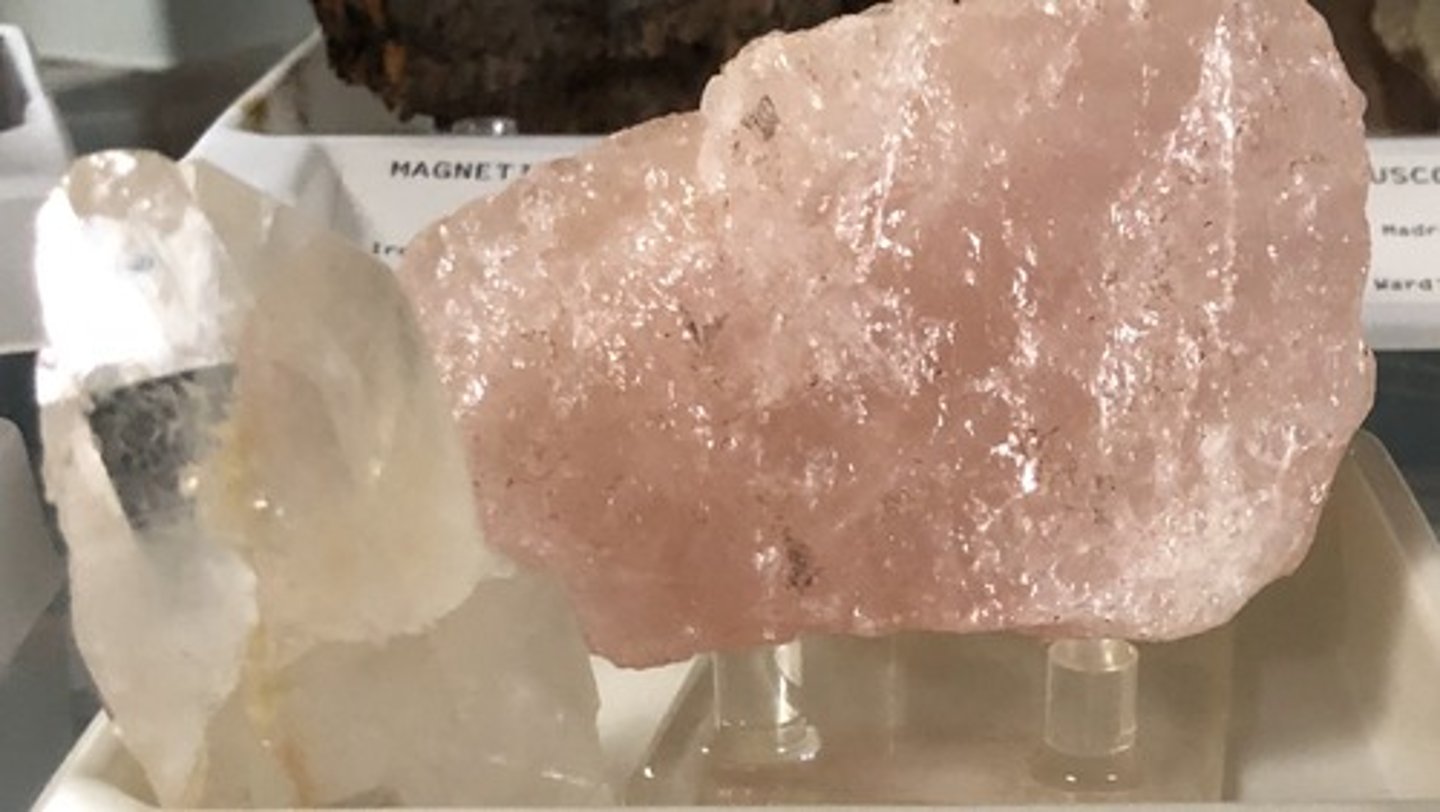
Sphalerite
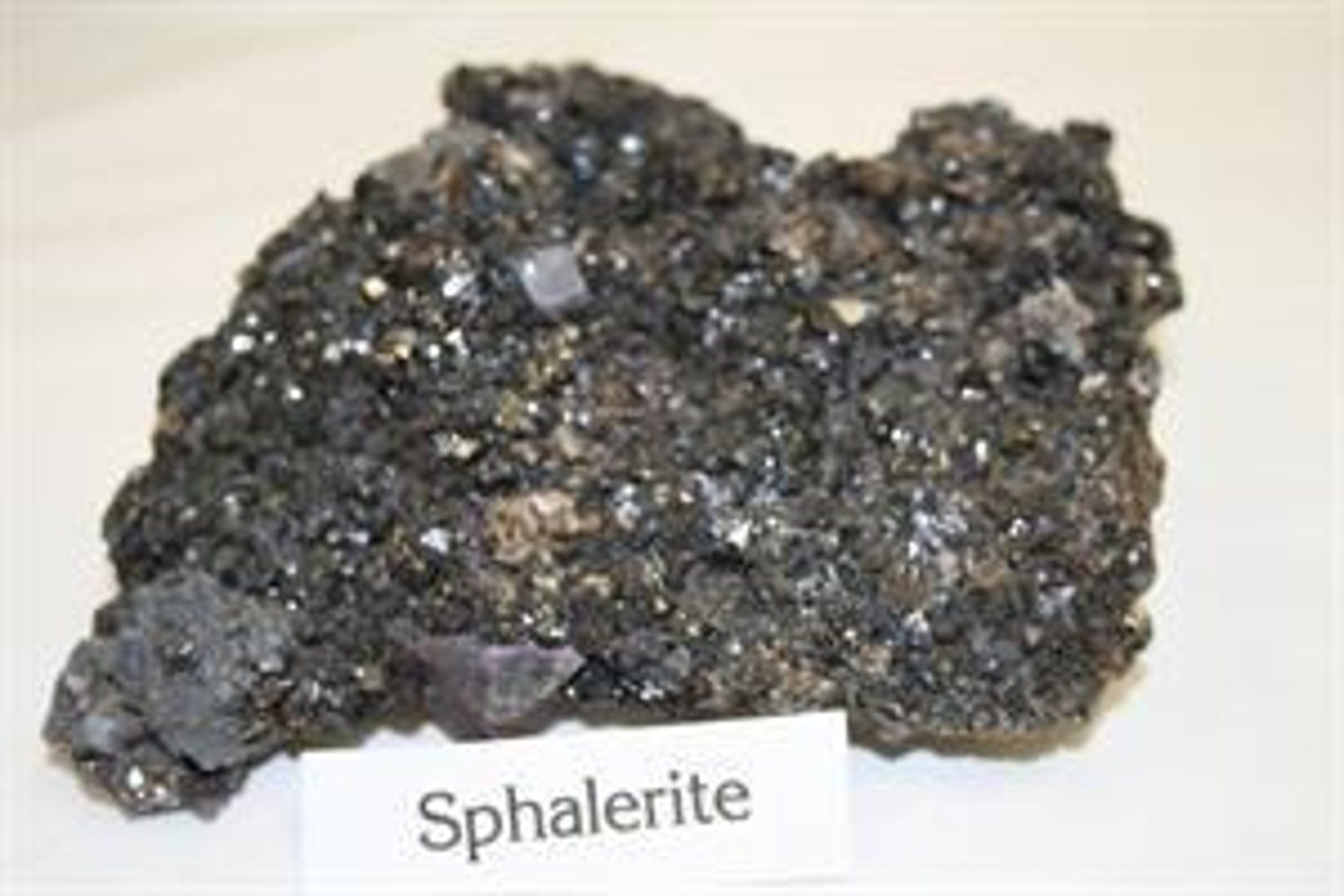
Yellow streak
Dark, Crystalline masses
Metallic luster on crystal faces
Resinous luster on cleavage surfaces
Rotten egg odor when scratched
H= 3.5-4
sphalerite

bright yellow, powdery masses, dull/earthy luster, rotten egg smell, H=1.5-2.5
sulfur
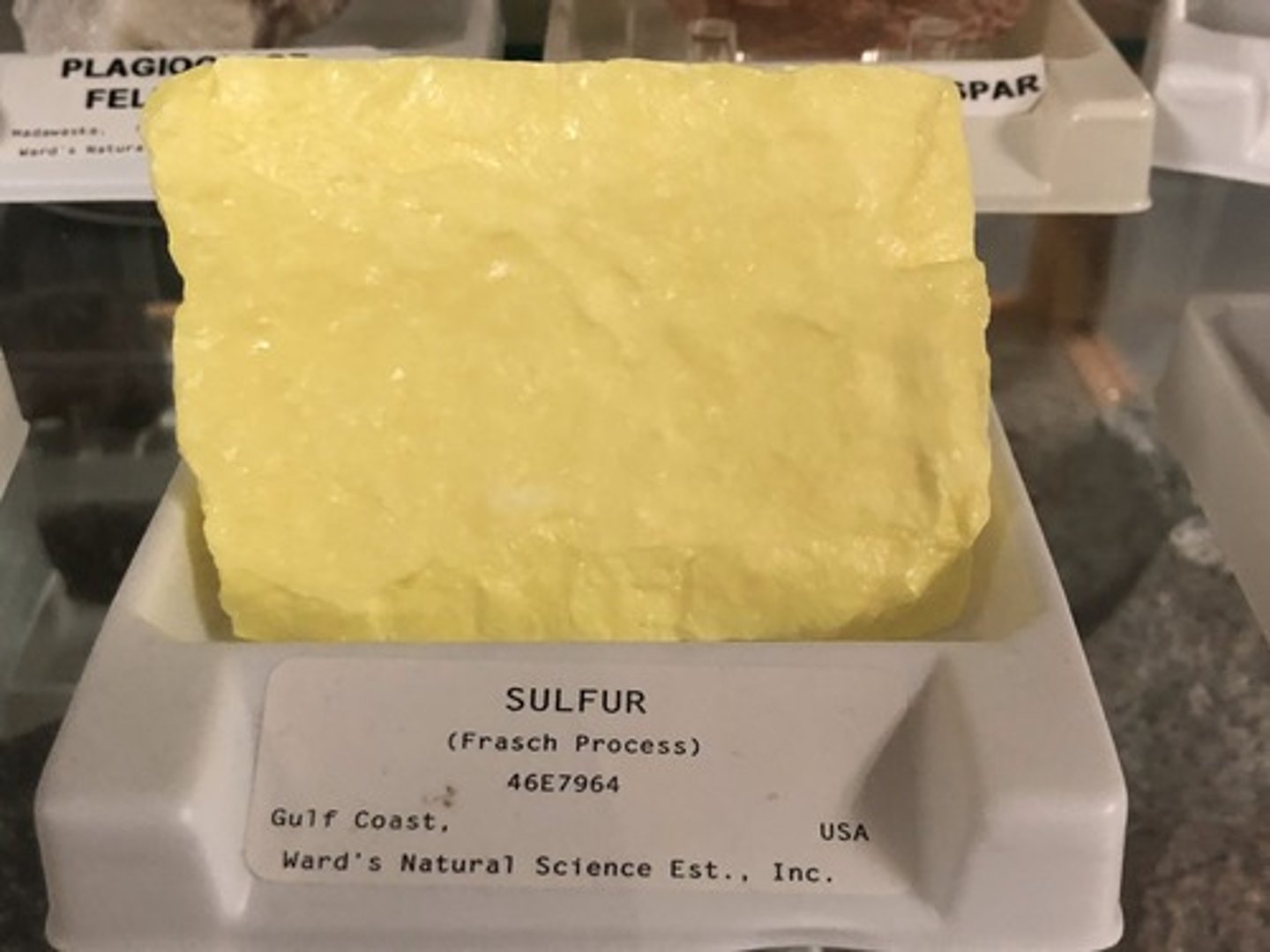
3.5
What hardness is a mineral scratched by a copper penny?
2.5
What hardness is a mineral scratched by a fingernail?
curved surface w a sharp edge
What is a conchoidal fracture?
6.5
What hardness must a mineral be to mark a streak plate?
5.5
What hardness must a mineral be to scratch glass?
white pink or green, pearly luster, feels soapy or greasy, H=1
talc
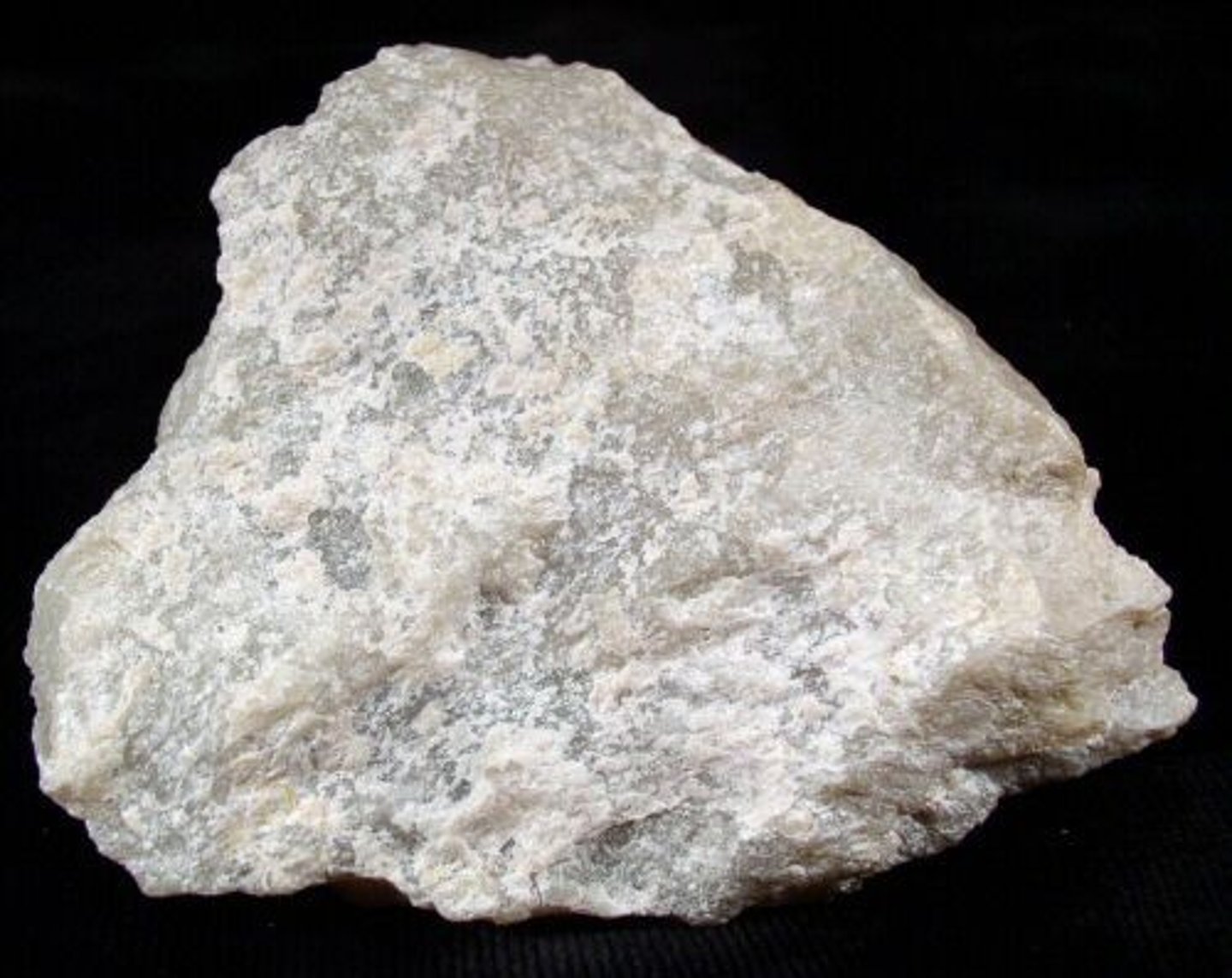
-crystals too small to be seen (need magnification)
-feels like sandpaper
-can be vesicular
Aphanetic
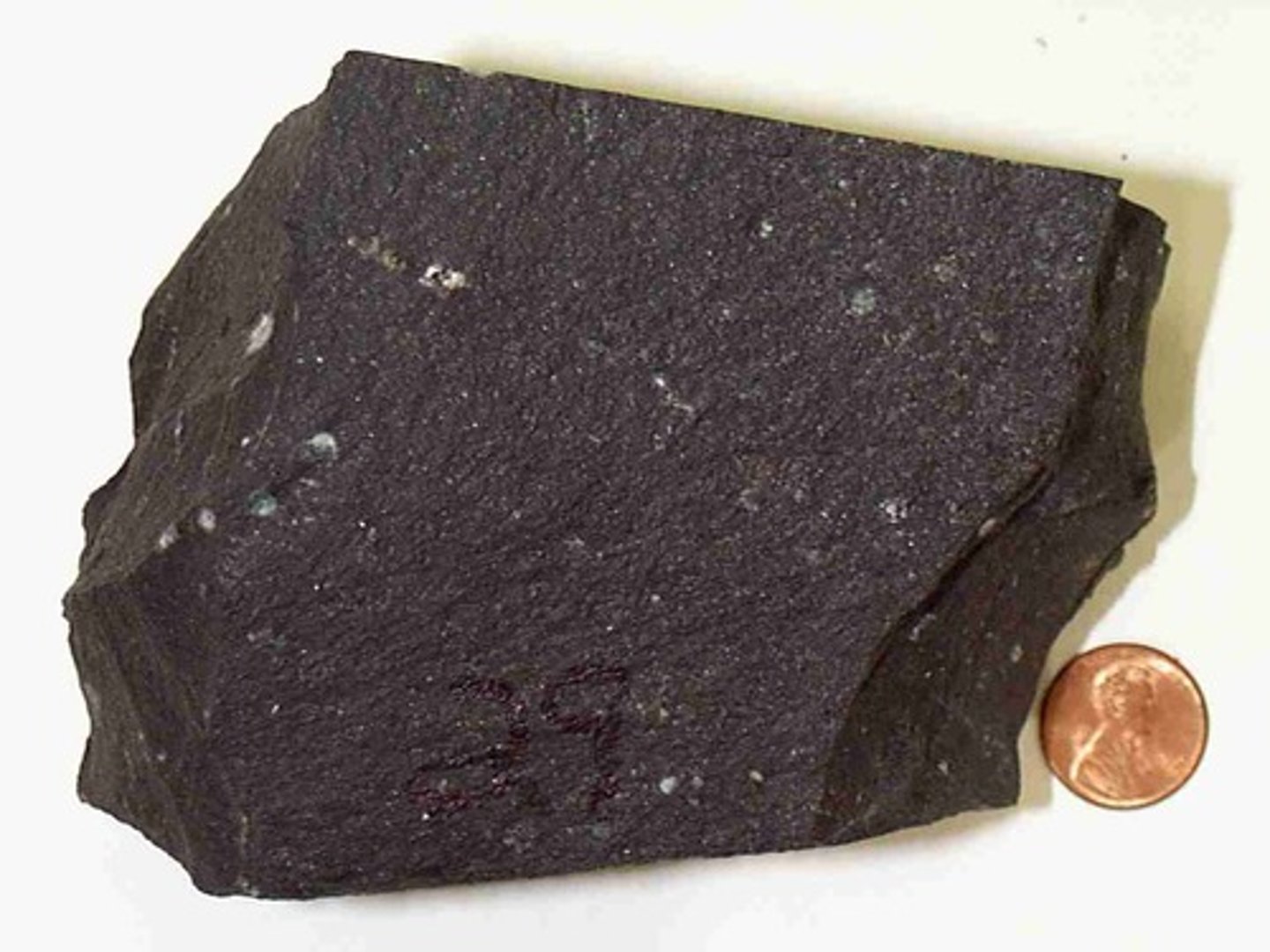
-crystals are large enough too see and can be used to identify the rock
Phaneritic
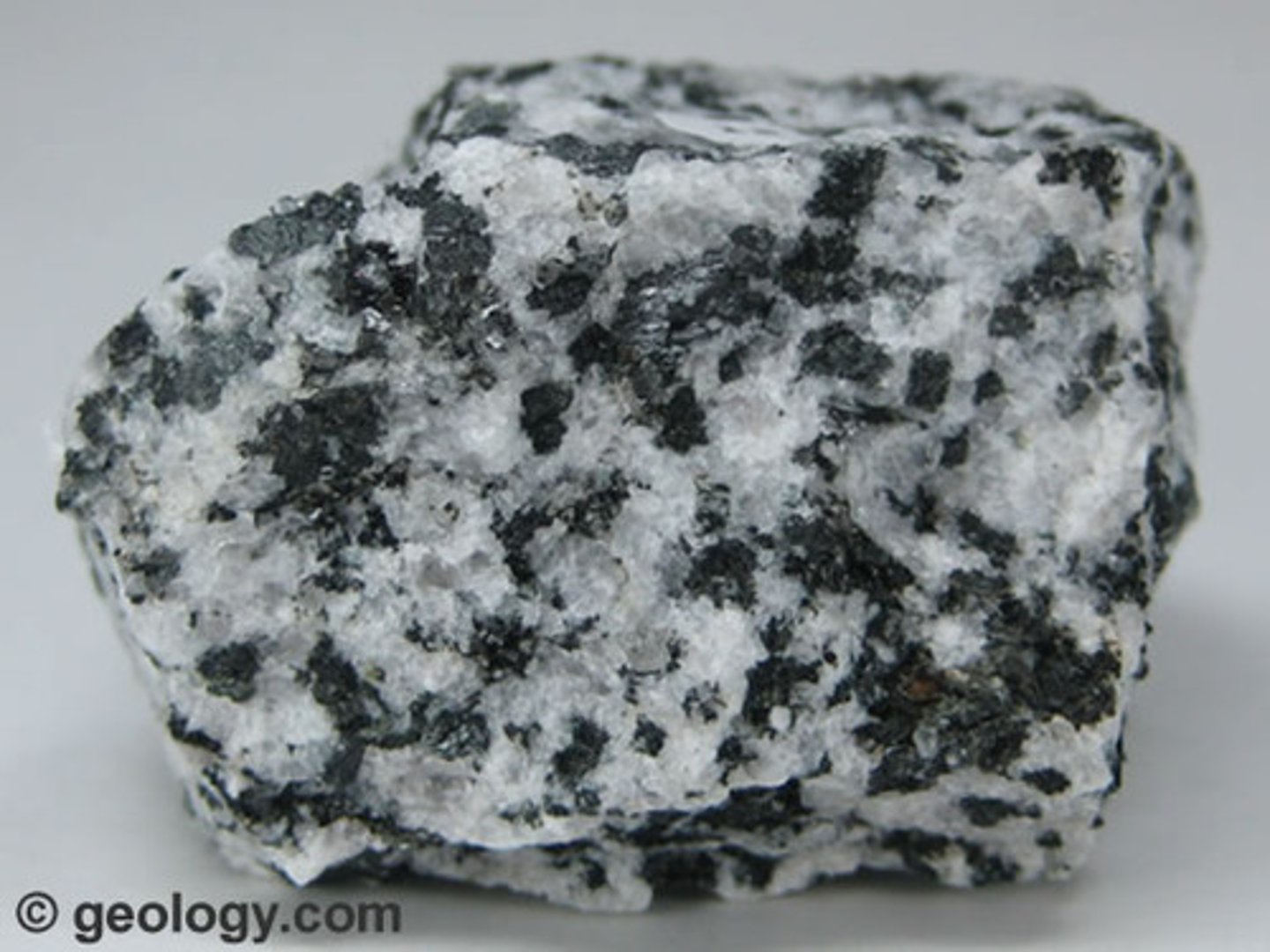
-has phenocrysts and ground mass
-cools from slow to rapid
Porphyritic
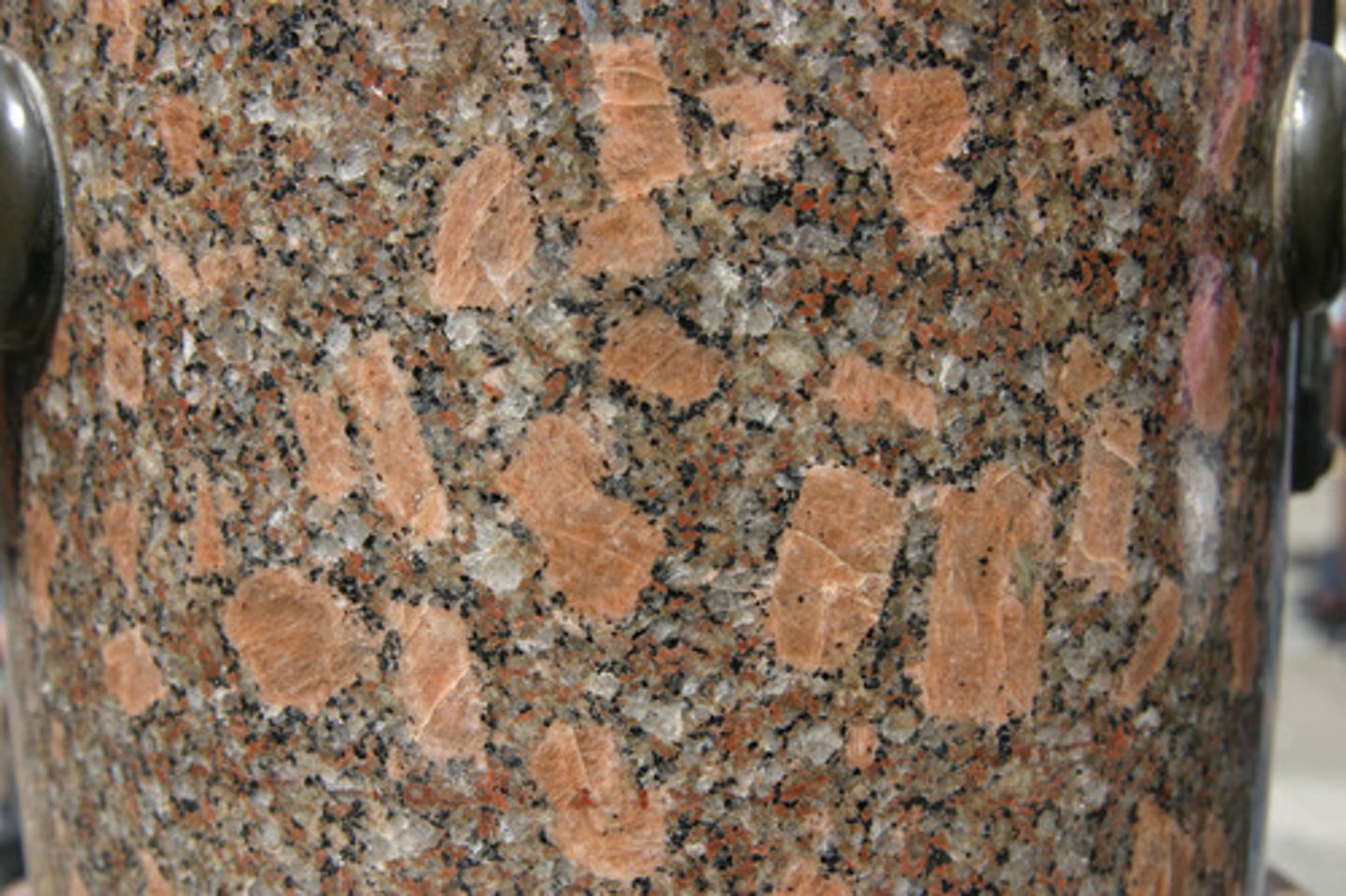
-wide range of grain sizes
-grain is not interlocked
-comes from volcanic ash
Pyroclastic
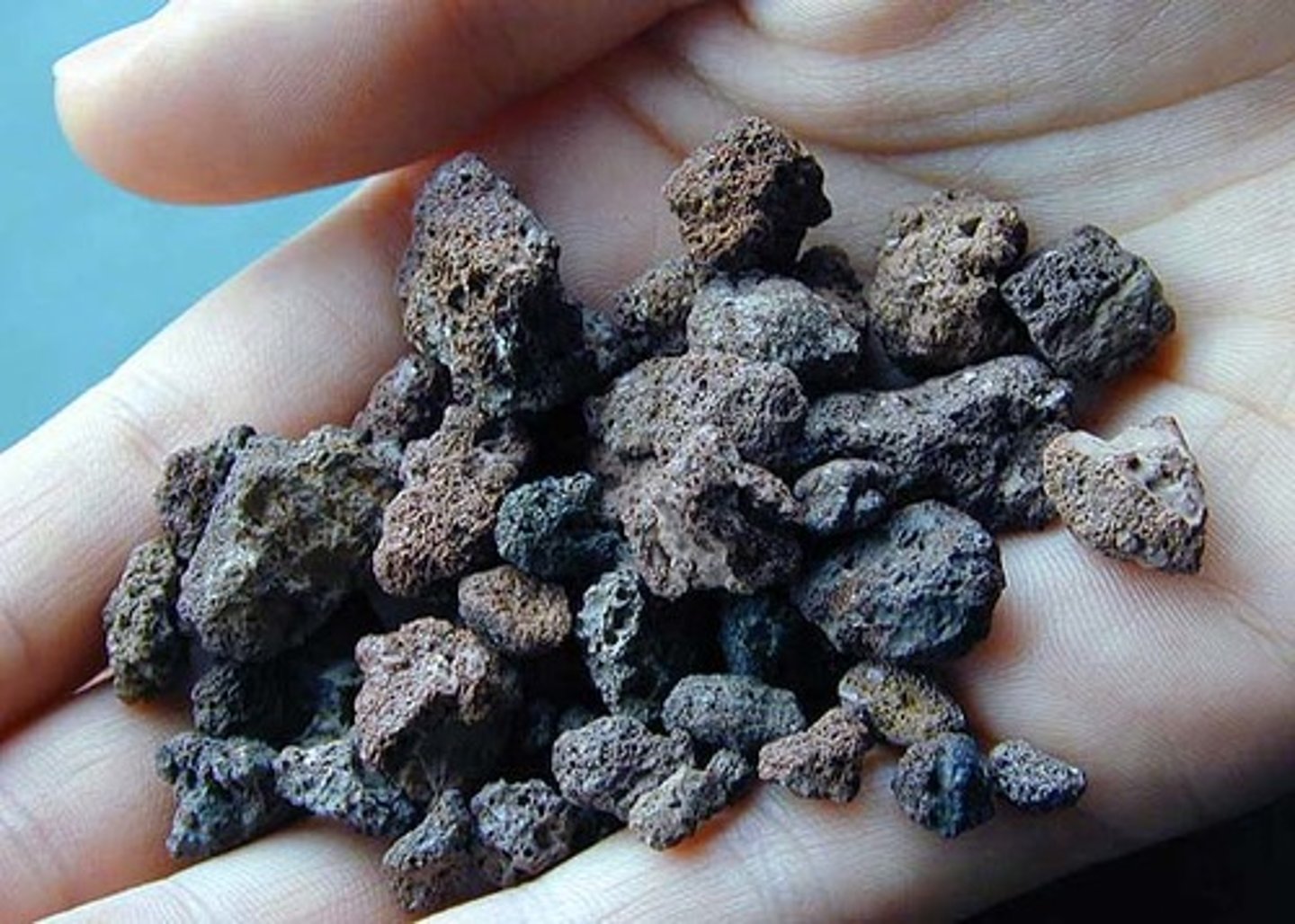
-very large
-forms in late stage of cooling
-cools fast
-lots of water and silica make the atoms move quickly
Pegmatic
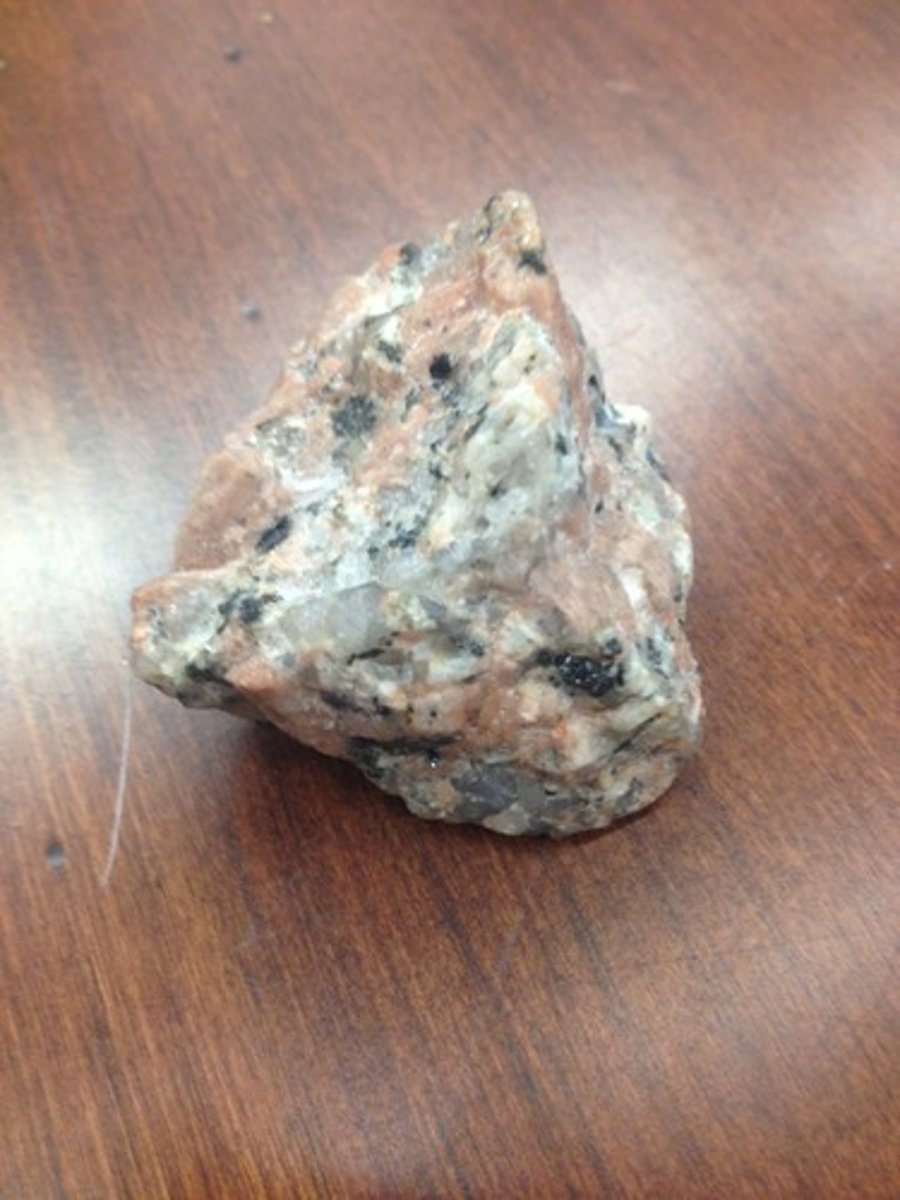
igneous rocks are made of _________ minerals
silicate
-has lots of iron and magnesium
-less silicate
-dark: black/green
ferromagnesium silicate
-has less iron and magnesium
-more silicate
-light: pink, white, clear
nonferromagnesium silicate
felsic, phaneritic and intrusive (quartz, feldspar, and mica)
granite
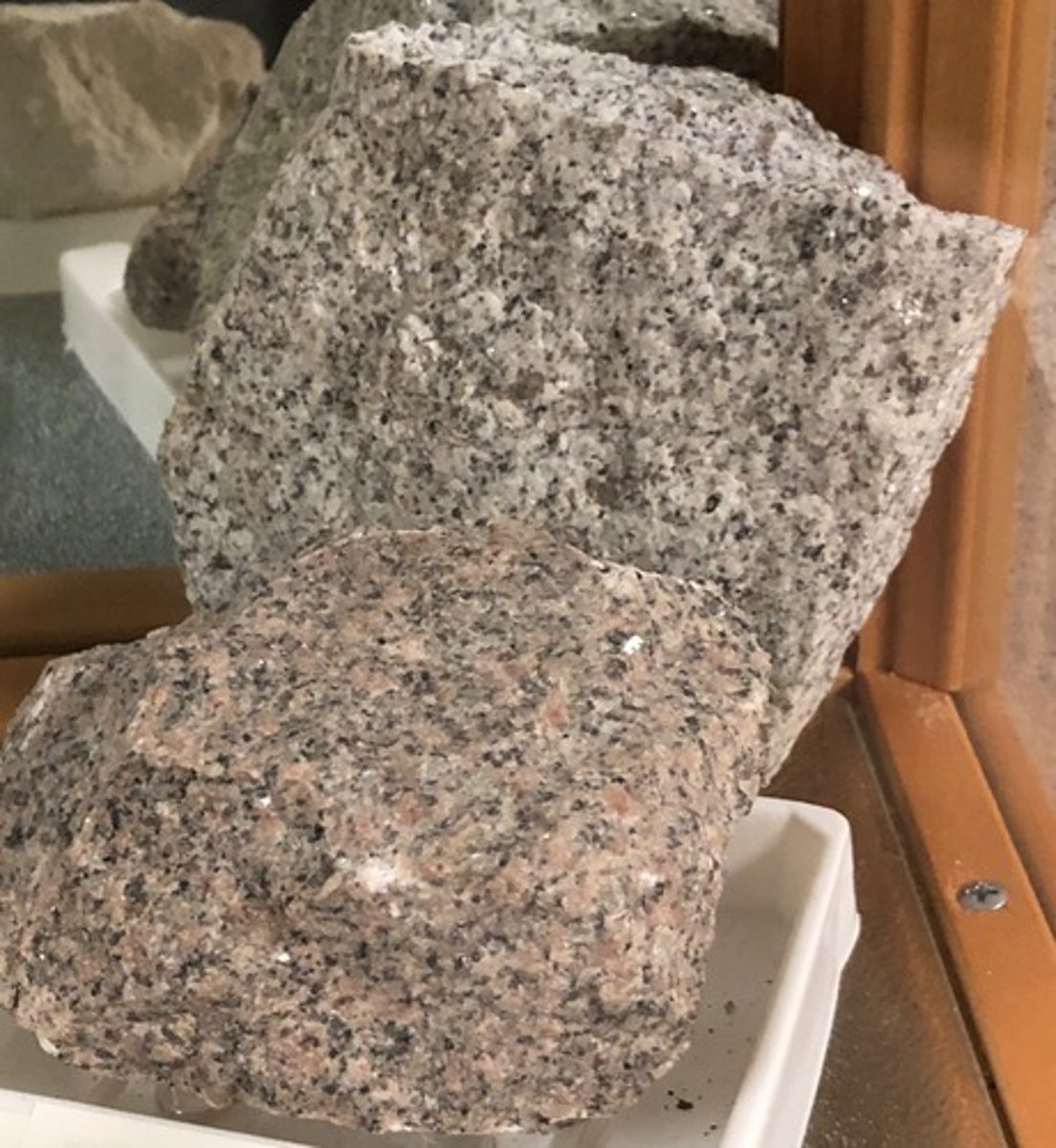
mafic, aphanitic and extrusive (plagioclase feldspar, pyroxene, olivine)
basalt
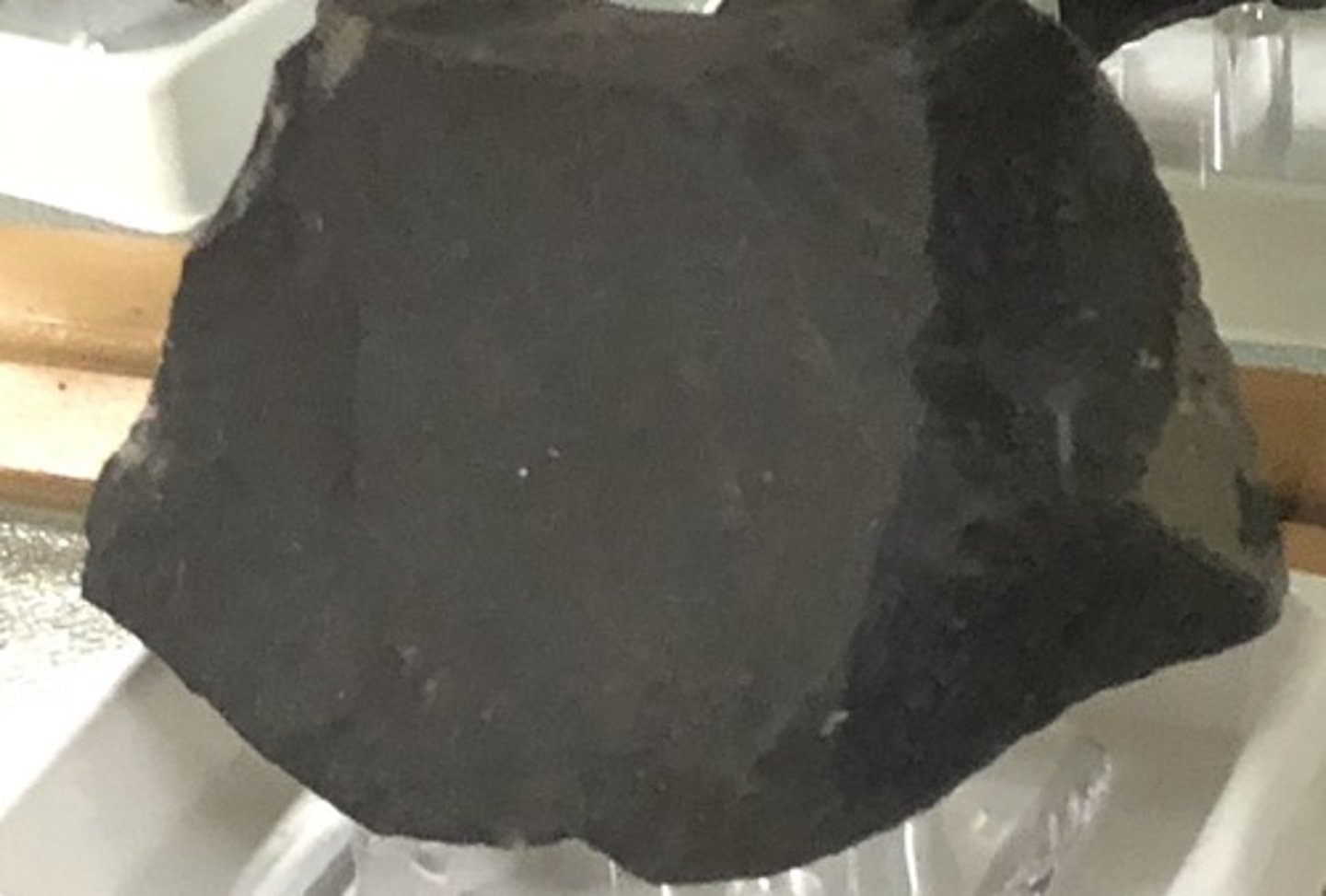
ultramafic, very high iron and magnesium, phaneritic, very low silicate and intrusive
peridotite
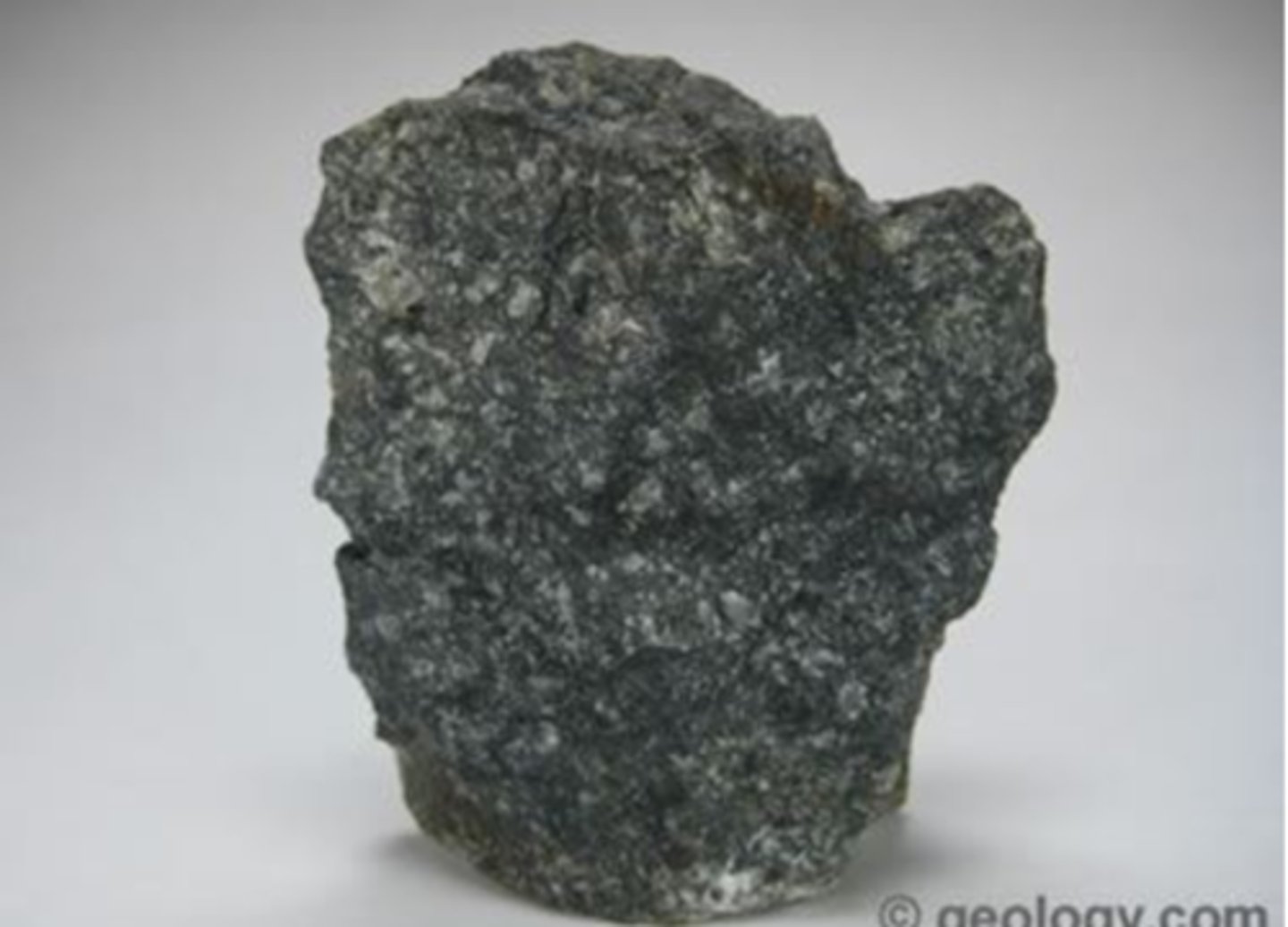
intermediate, aphanitic and extrusive
(middle iron and magnesium, middle silica,plagioclase, amphibole) (pic has hornblende in it as well)
andesite
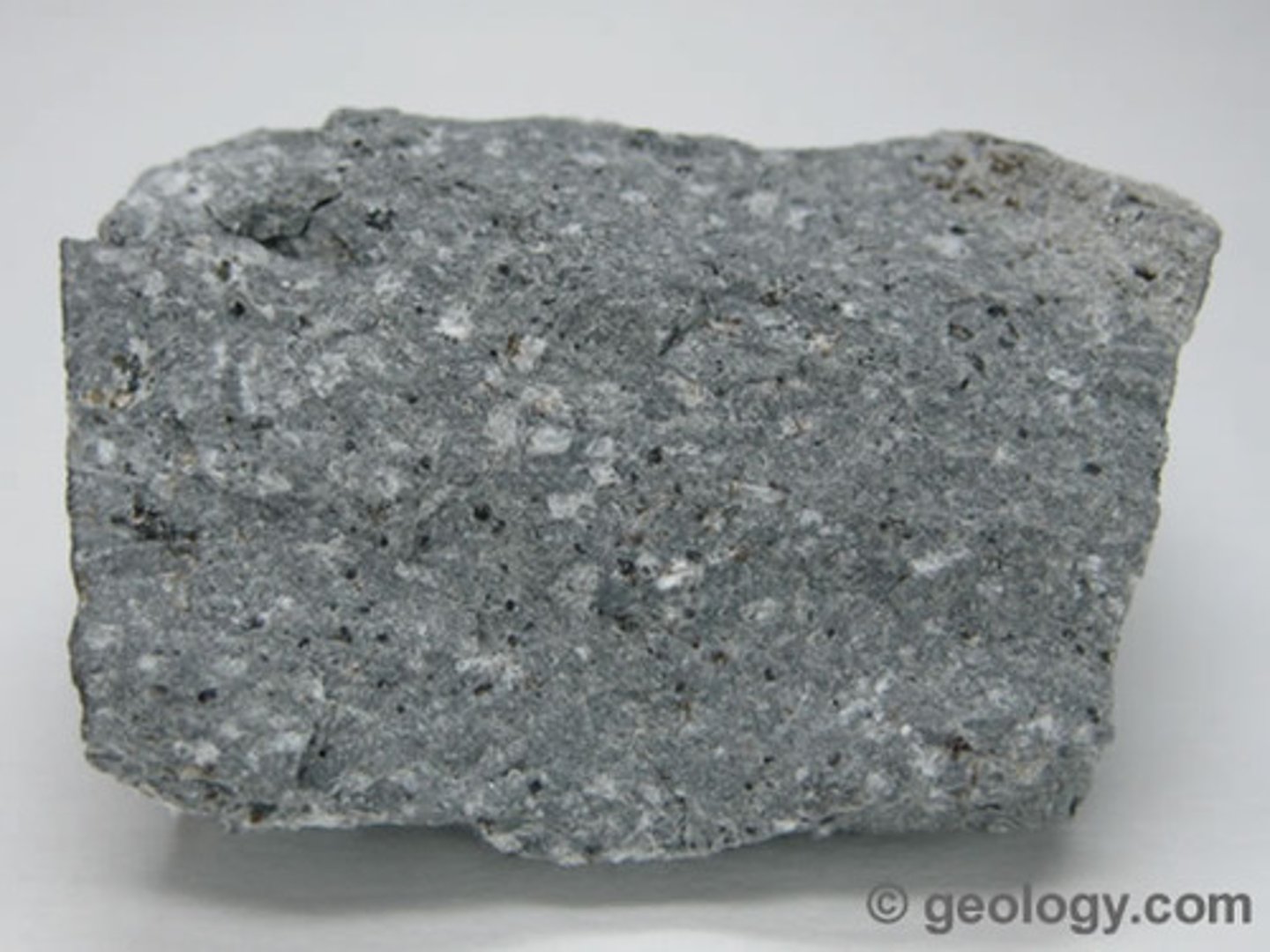
felsic, aphanitic texture, extrusive
EXAMPLE: Yellowstone park
rhyolite
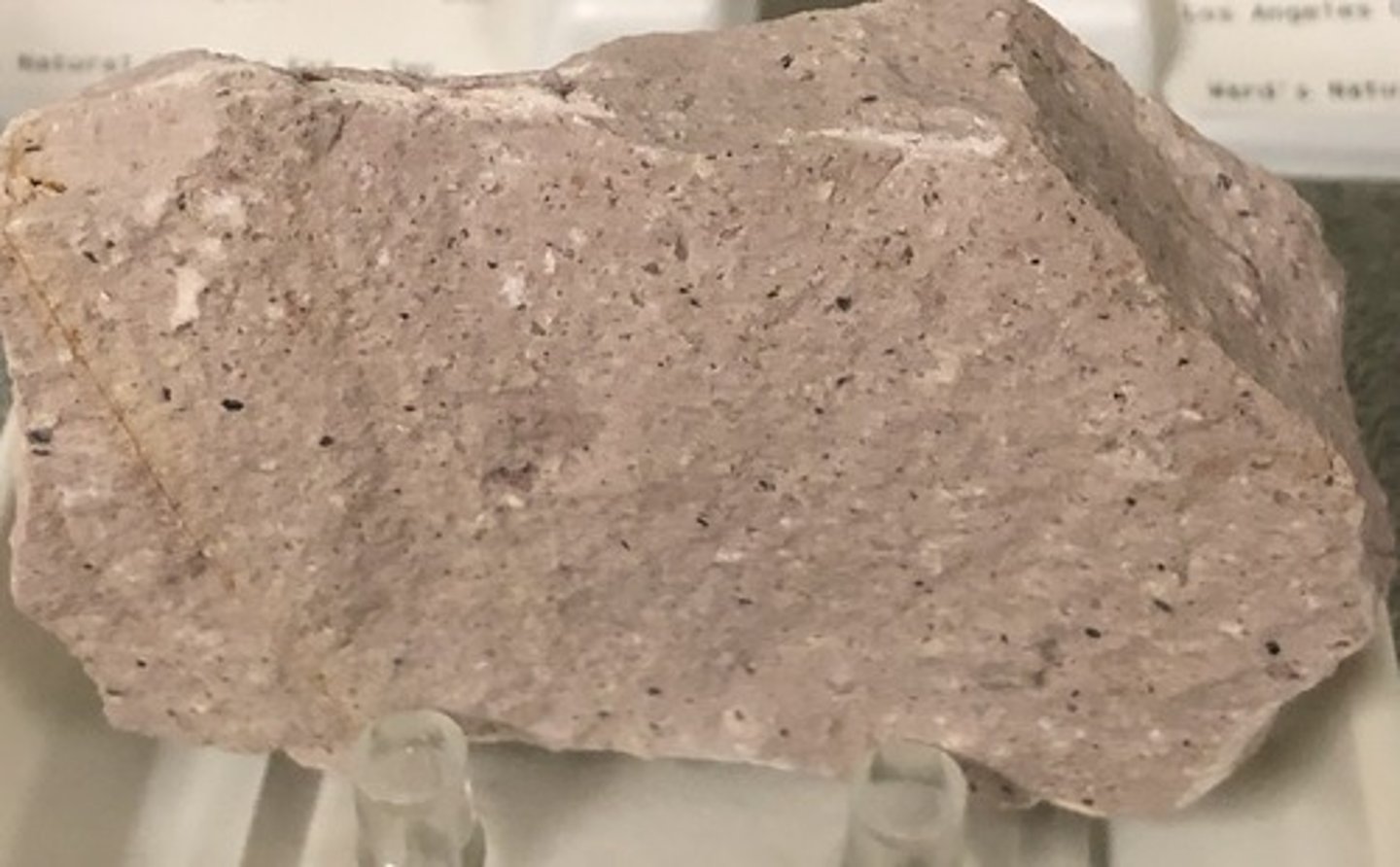
felsic, intermediate or mafic, extrusive, glassy texture (no minerals)
EXAMPLE: lava cools instantly
obsidian
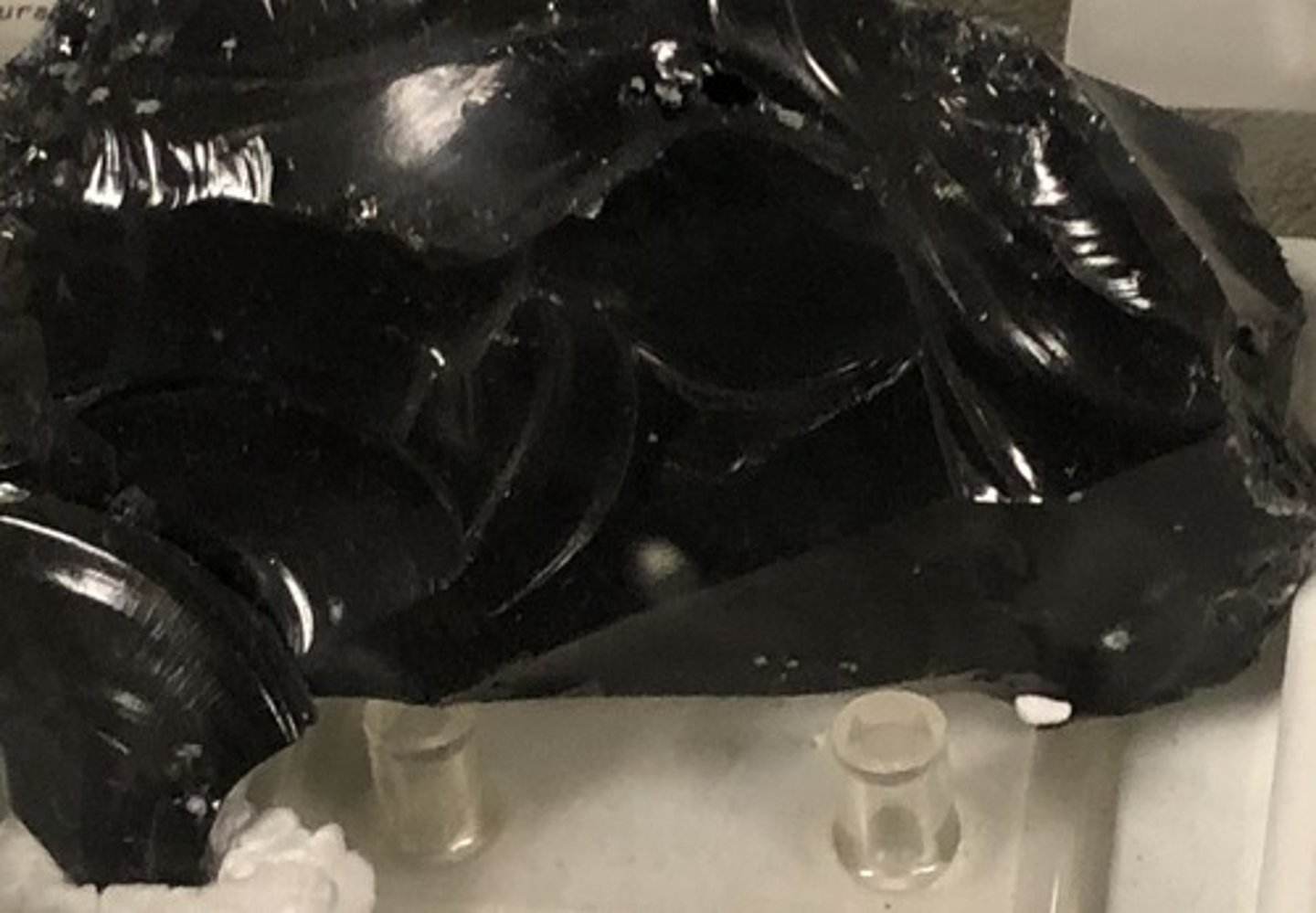
felsic to intermediate, vesicular texture, extrusive
EXAMPLE: lava cools instantly
pumice
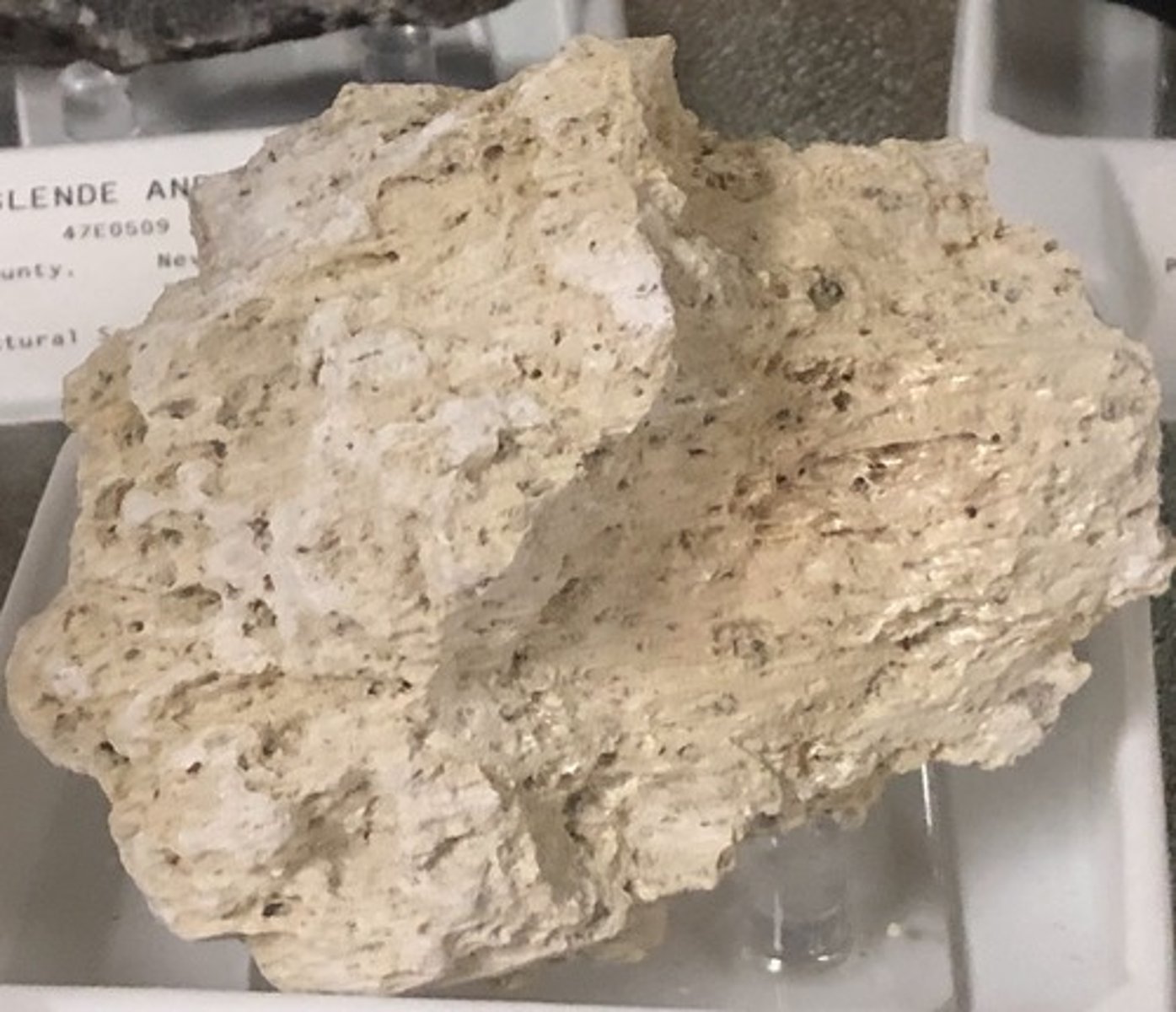
-granite
-rhyolite
-obsidian
-pumice
felsic composition (4 types)
intermediate comp, phaneritic texture, intrusive
(plagioclase, amphibole)
diorite
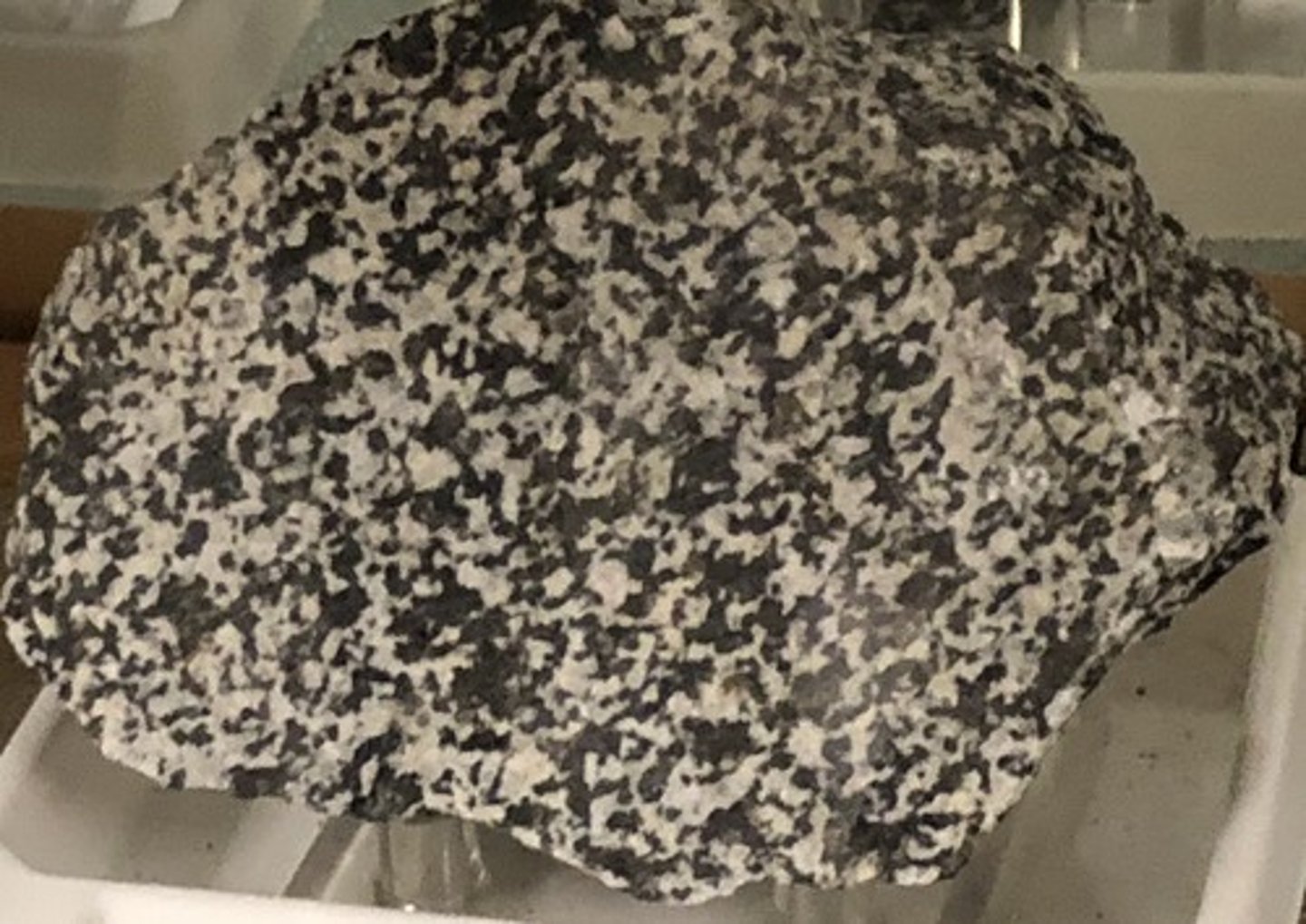
-mafic comp intrusive
-plagioclase feldspare, pyroxene, olivine
-phaneritic texture
PLATE TECTONICS: oceanic crust
gabbro
